First edition hardback Hobbits (UK)
2023-7-3 3:52:52 PM UTC
First edition Hobbits (UK)
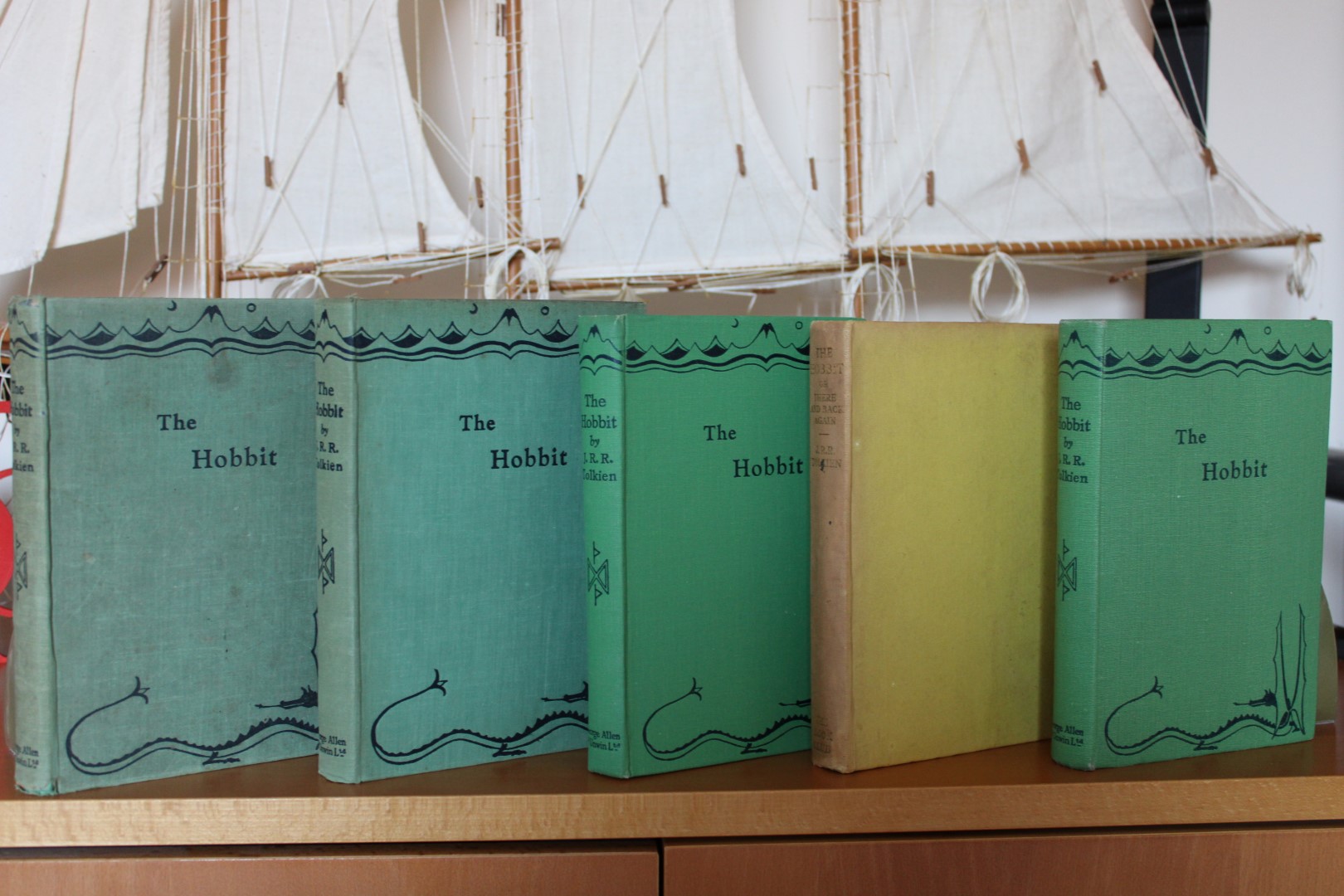
UK 1st edition Hobbits, 1st impression, 2nd impression, 3rd impression, Book Club edition, 4th impression (left to right)
This article is an introduction to the first UK hardback printings of The Hobbit by J.R.R. Tolkien, published between 1937 and 1946 in the UK.
Additionally, I include a brief mention of what I think, is the only translation of the 1st edition text of The Hobbit by Kooperativa förbundets bokförlag in 1947.
This article does not cover the 1938 US Hobbit, which is covered in First Edition Hardback Hobbits (US).
1937 George Allen & Unwin Samples and Proofs
According to the article on TolkienBooks.net, link at bottom, 28 Traveller's Samples were produced, these were probably the book binding and the first couple of chapters to give an example of what the book would like to book buyers, and 21 paper bound copies, which were probably review copies.
Would love to know more about these if anyone has any information or images of these?
1937 George Allen & Unwin Dust-jacket and endpapers
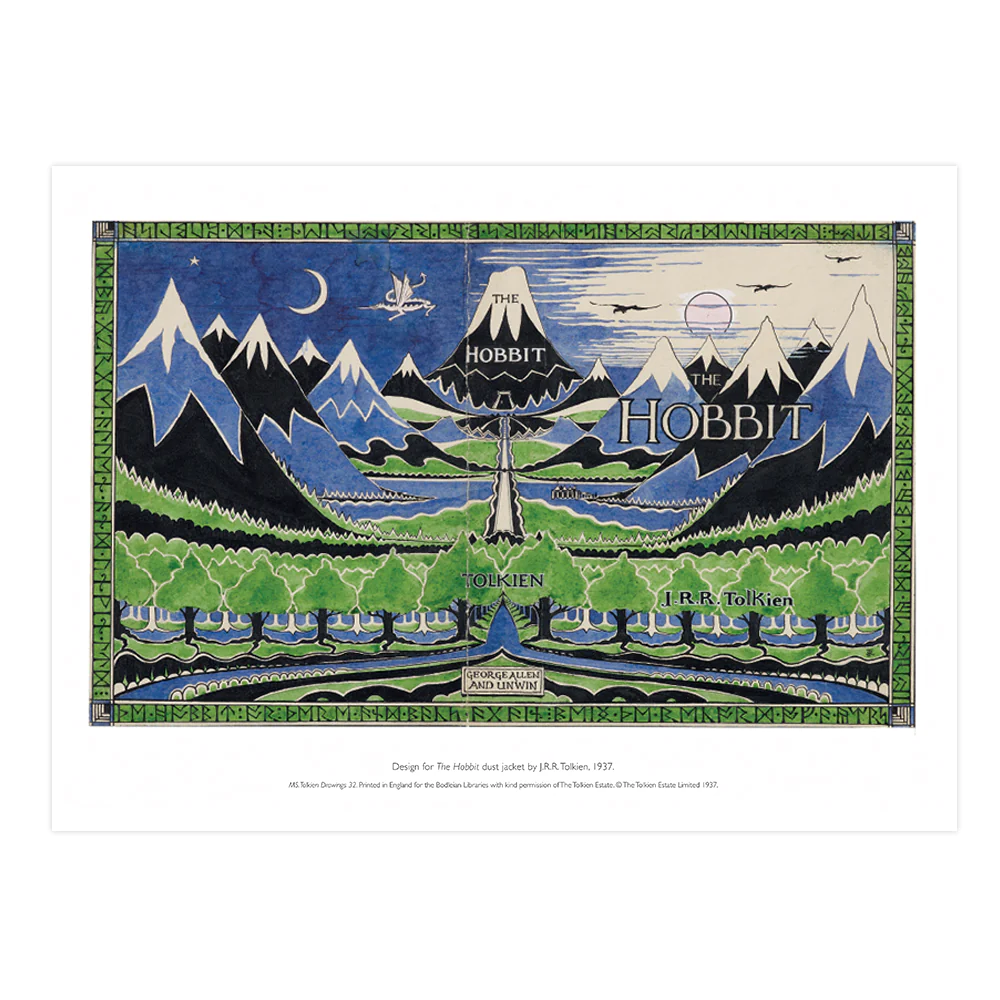
MS. Drawings 32. ©The Tolkien Estate Limited 1937
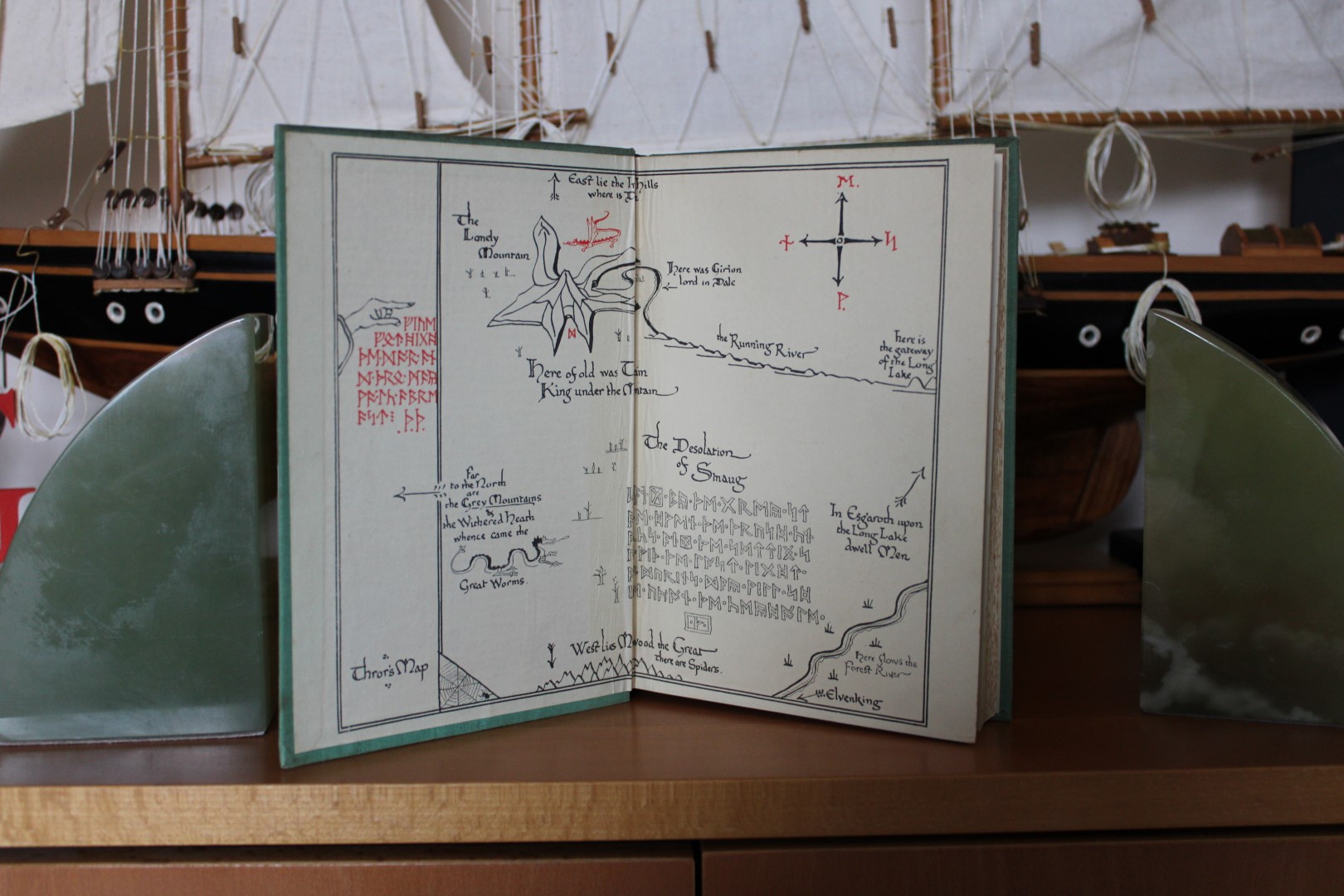
1937 front endpaper: Thror’s Map
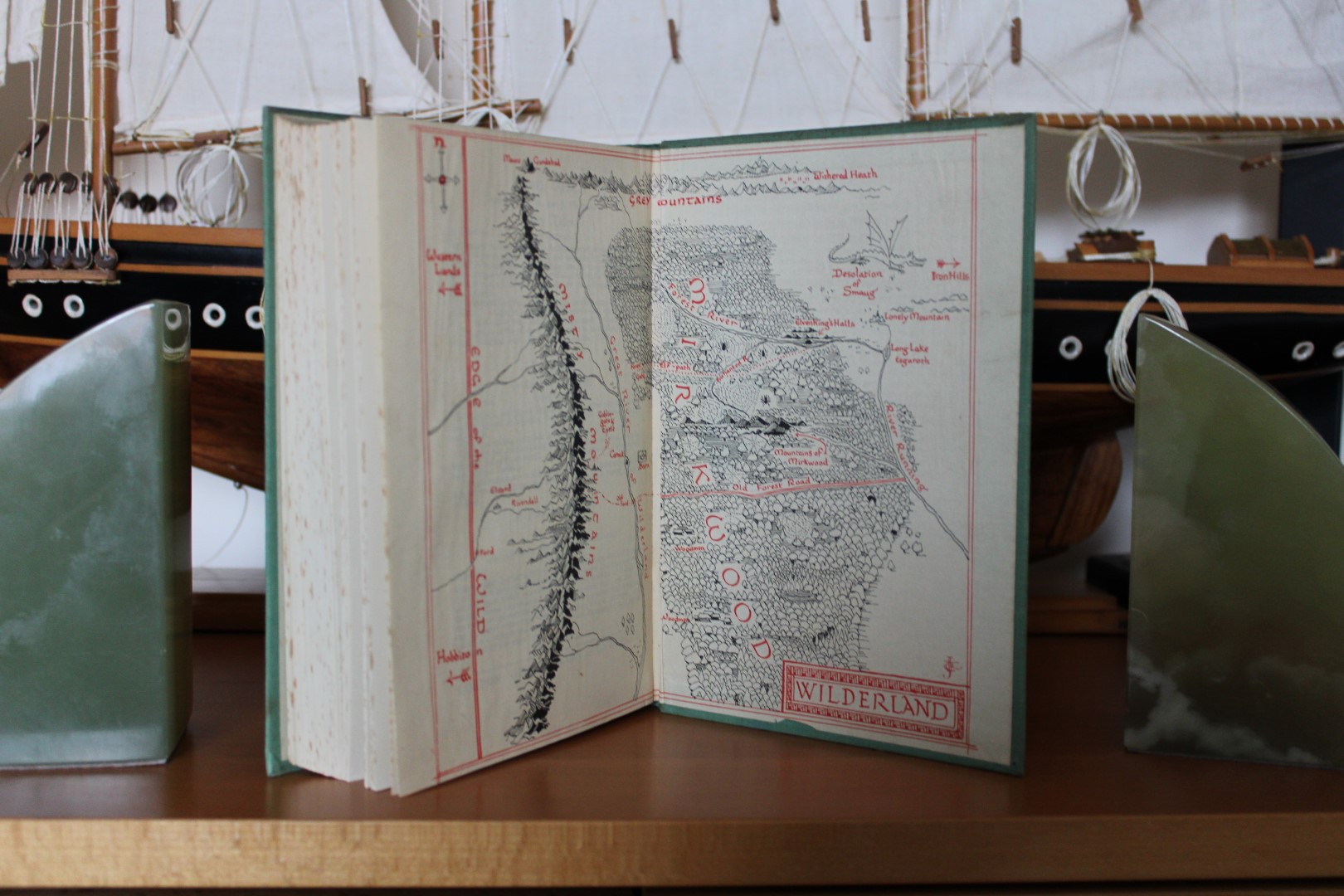
1937 rear endpaper: Map of Wilderland
The Anglo-Saxon runes on the dust-jacket when translated read as
The Hobbit or There and Back Again, being the record of a year’s journey made by Bilbo Baggins of Hobbiton compiled from his memoirs by J.R.R. Tolkien and published by George Allen and Unwin Ltd.
The Art of the Hobbit edited by Wayne G. Hammond & Christina Scull
The endpaper maps were re-coloured from Tolkien's original maps, which were redrawn in black and red instead of black and blue. You can see the original maps in The Art of the Hobbit by Hammond and Scull.
1937 George Allen & Unwin 1st impression
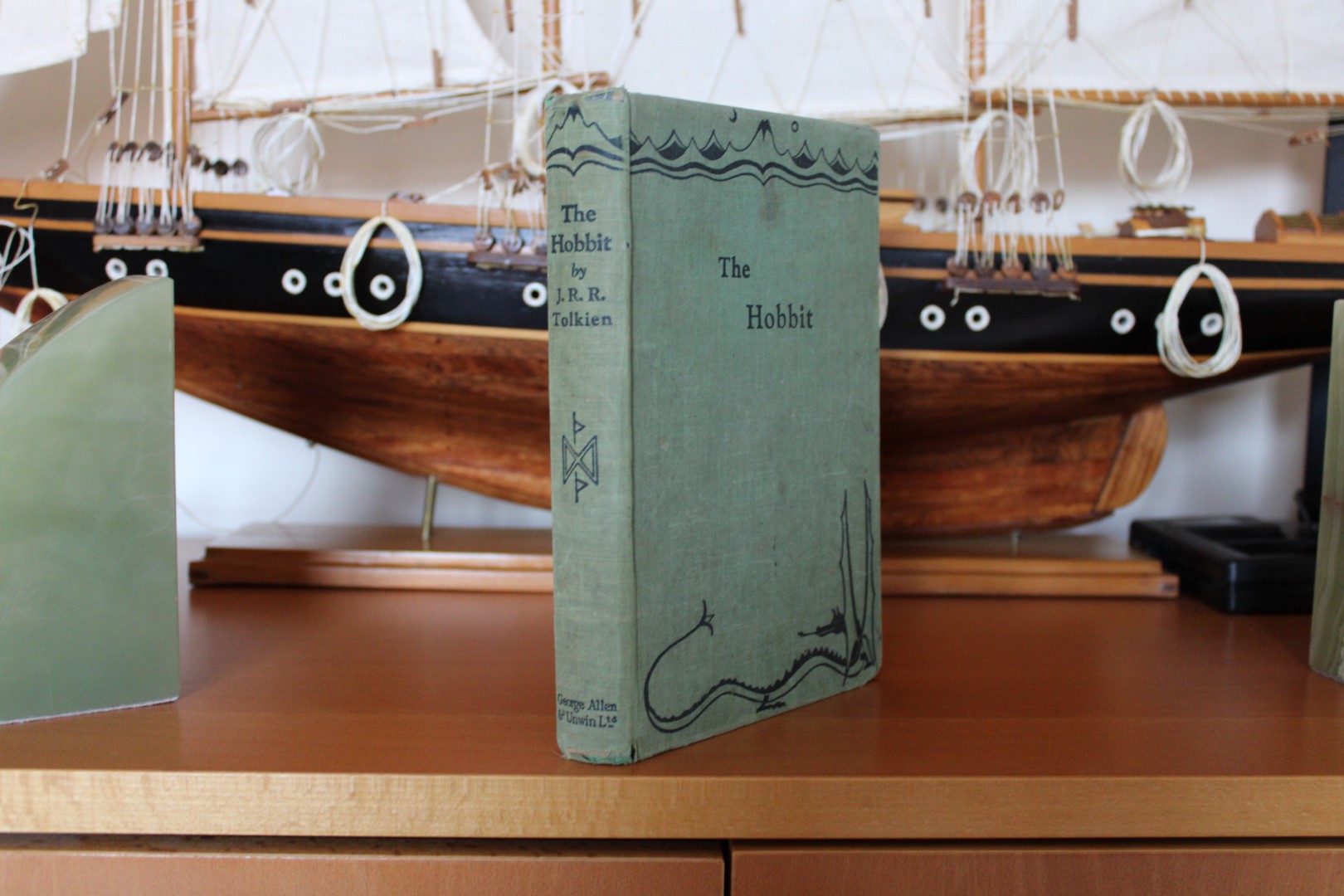
Binding of the 1st impression
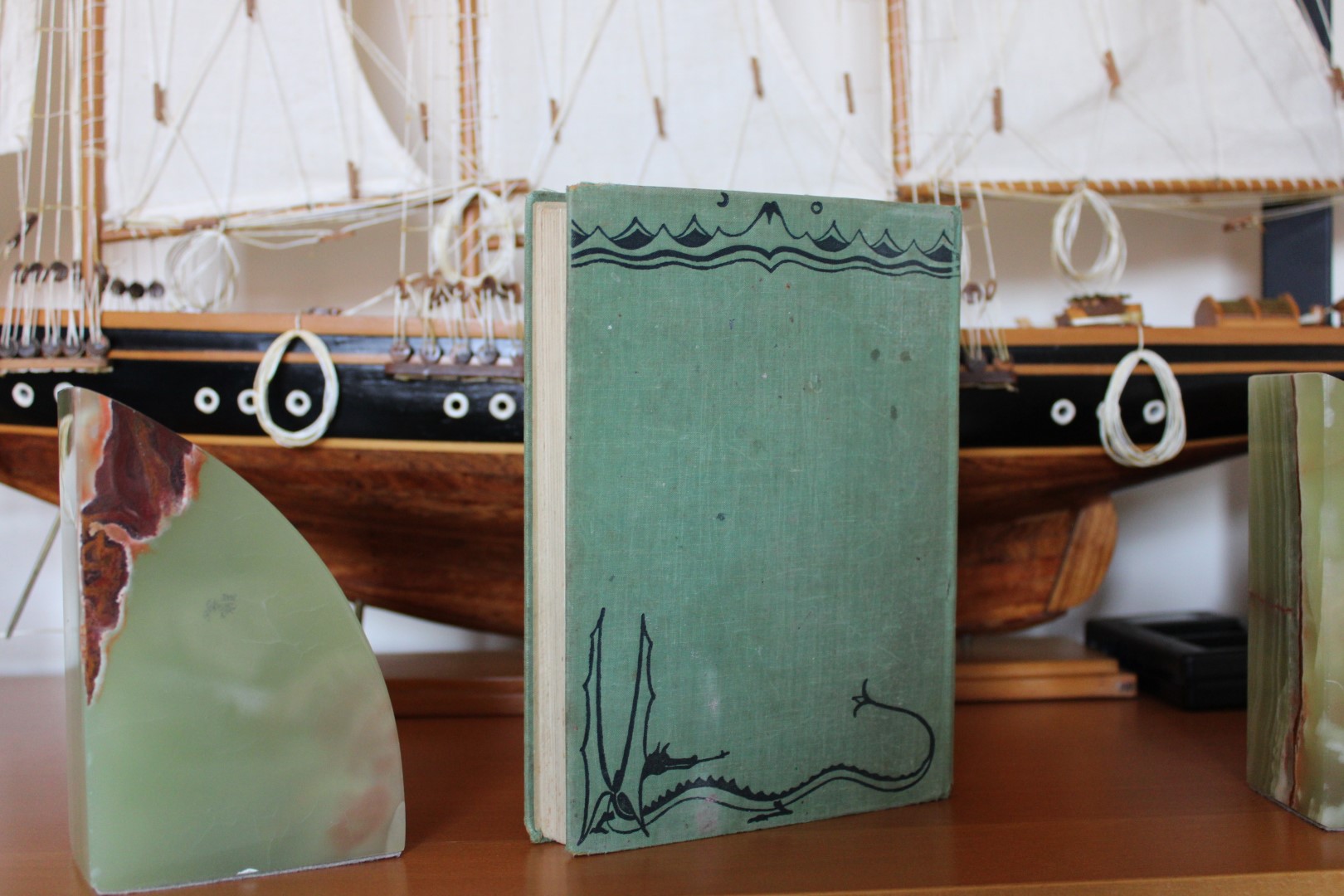
Binding of the 1st impression
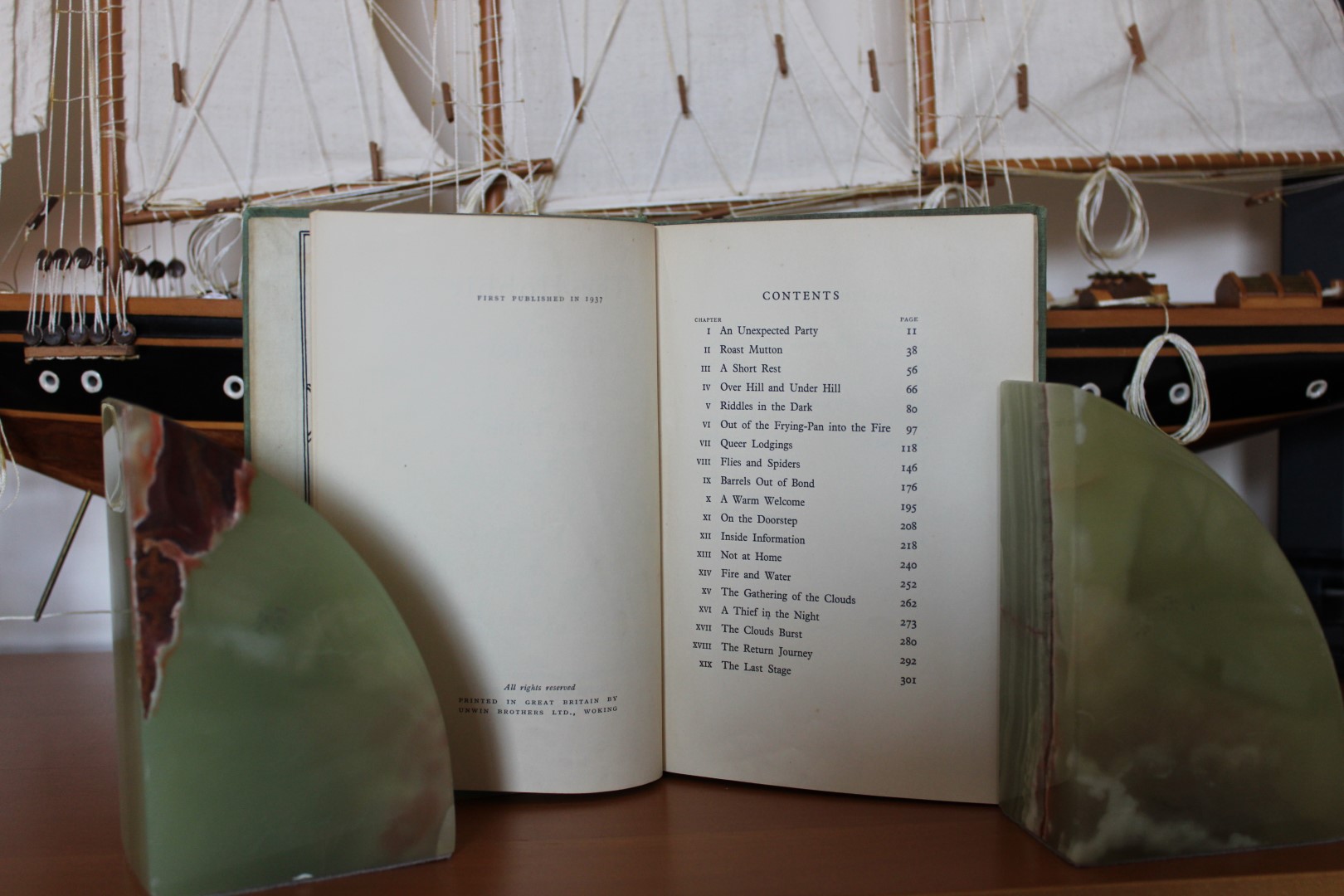
1st impression Copyright Page
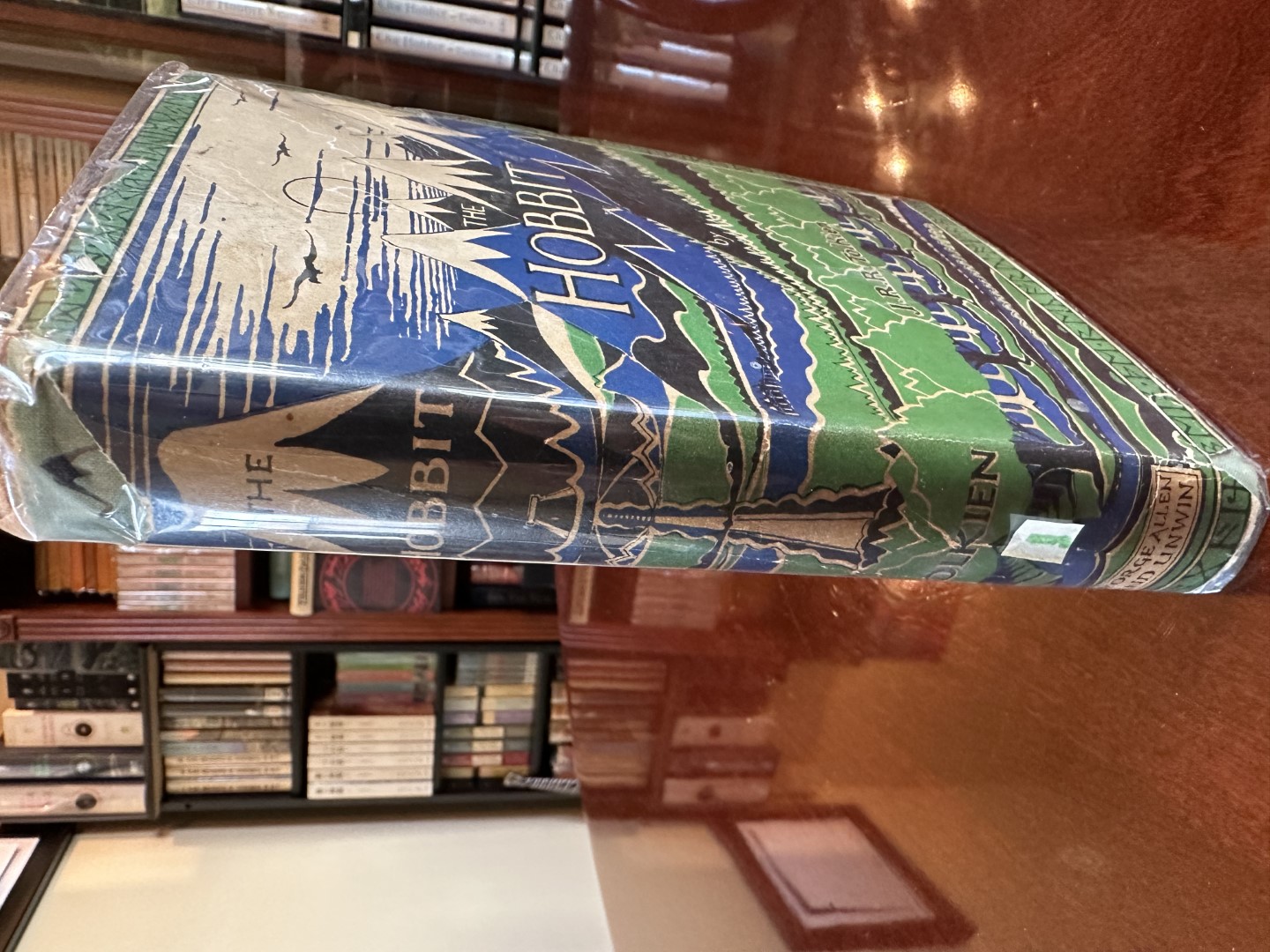
1st impression Dust-jacket (LanceFormation)
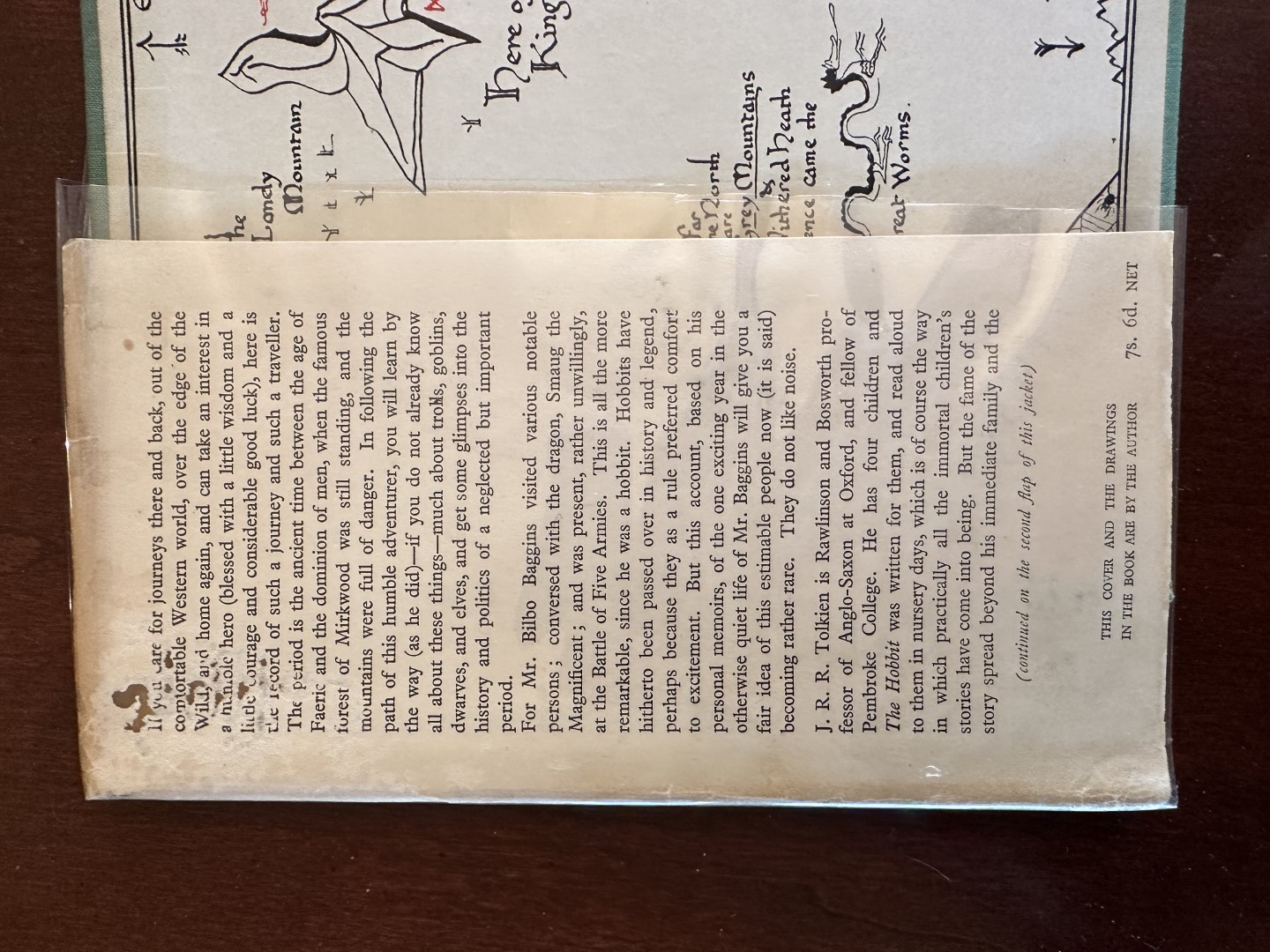
1st impression Dust-jacket Blurb (LanceFormation)
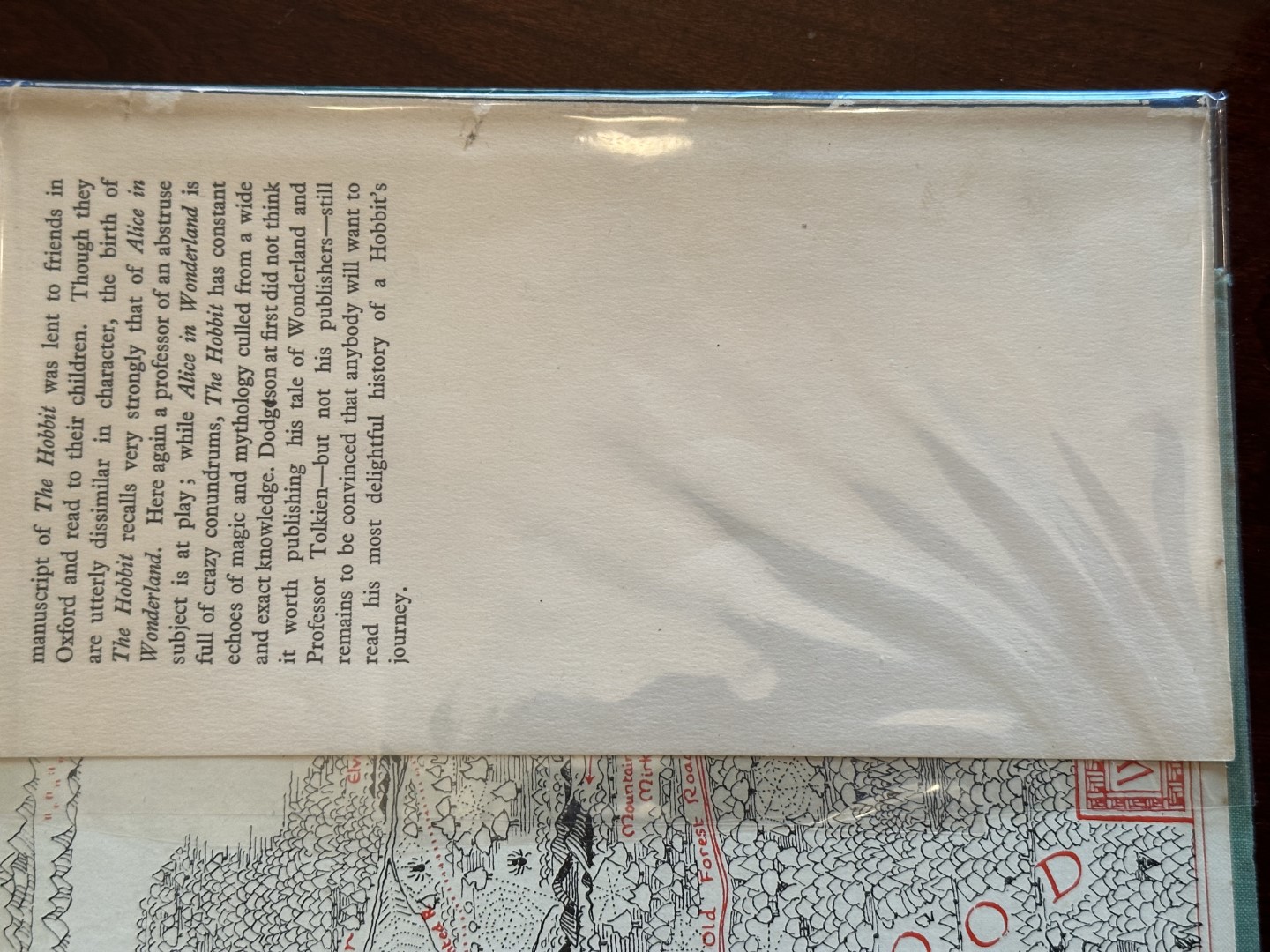
1st impression Dust-jacket Blurb (LanceFormation)
The first printing was published on the 21st September 1937 and 1,488 copies were printed. All the illustrations are black and white, including The Hill and Mirkwood. The dust-jacket which was illustrated by Tolkien had a printing mistake, Charles Dodgson's name was spelt Dodgeson and this was hand-corrected on all copies.
This printing sold well, and George Allen & Unwin reprinted in December 1937.
1937 George Allen & Unwin 2nd impression
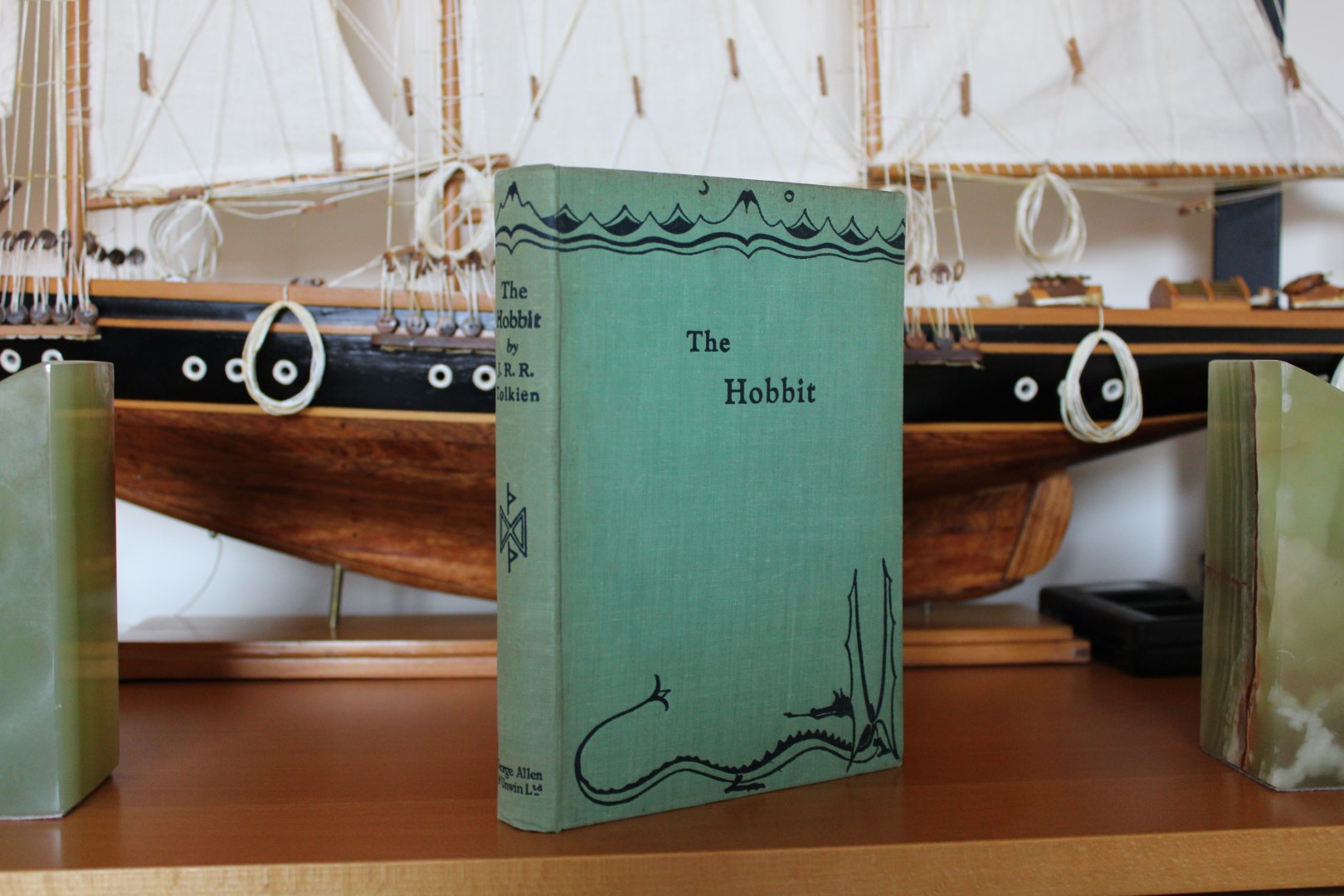
Binding of the 2nd impression
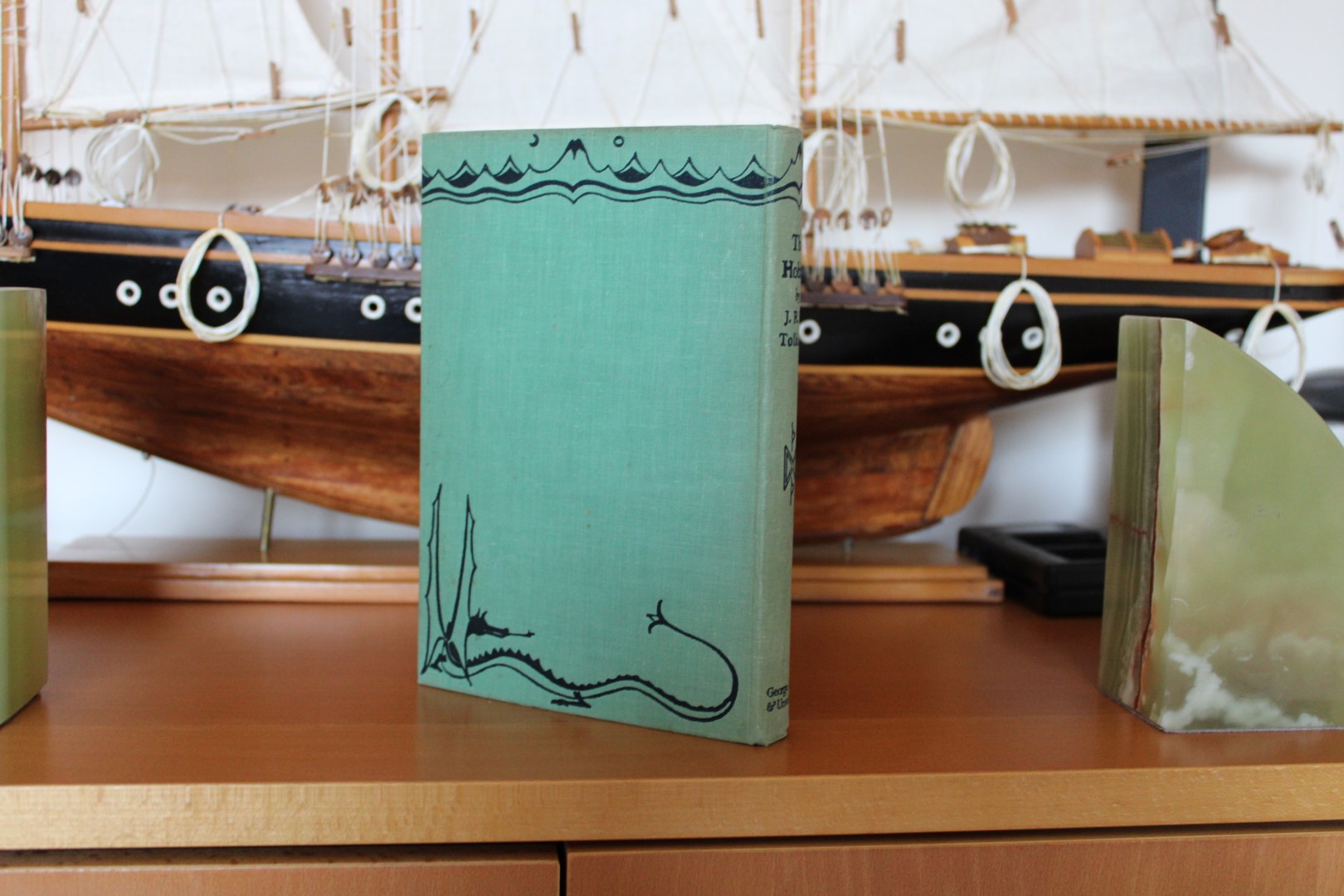
Binding of the 2nd impression
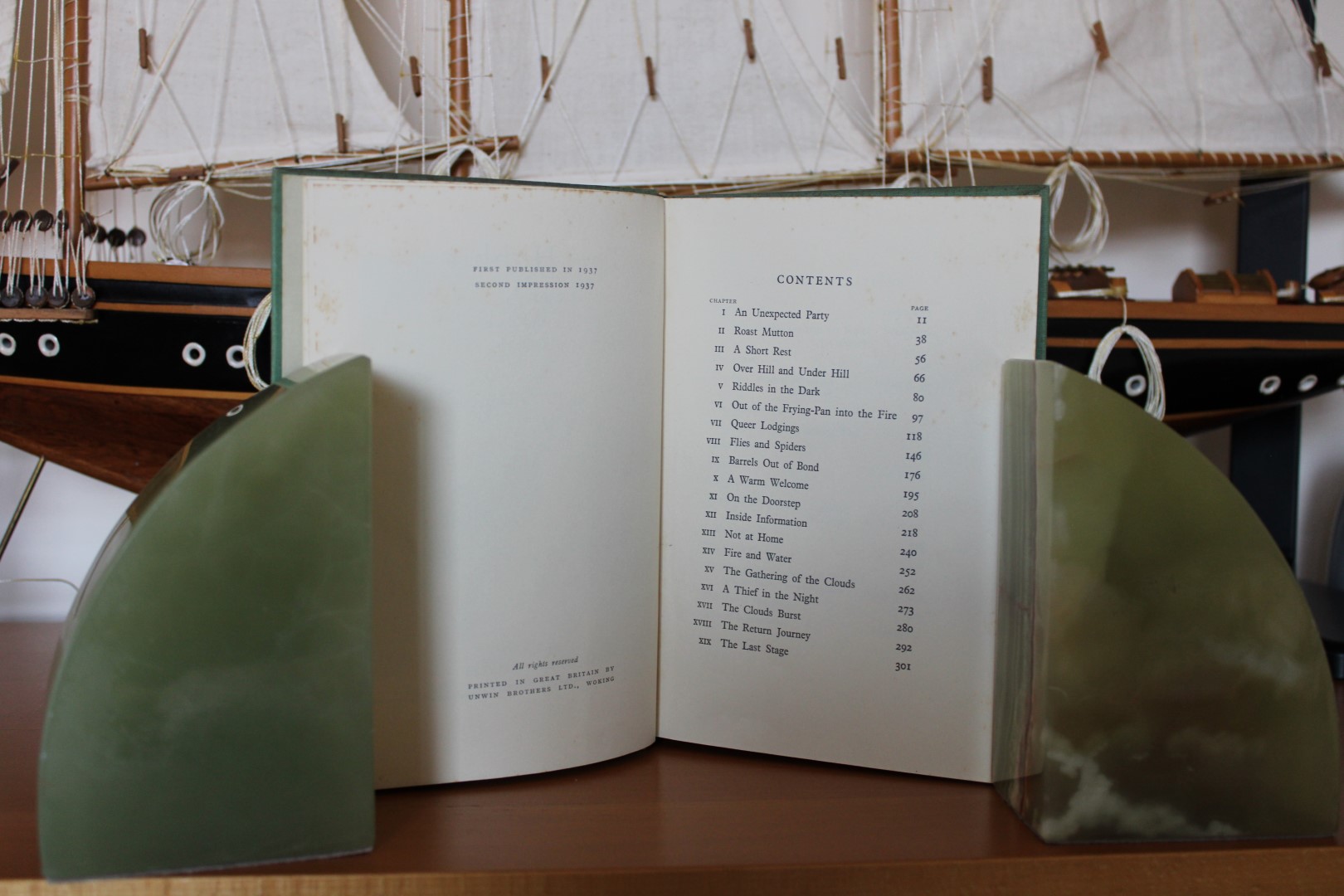
2nd impression Copyright Page
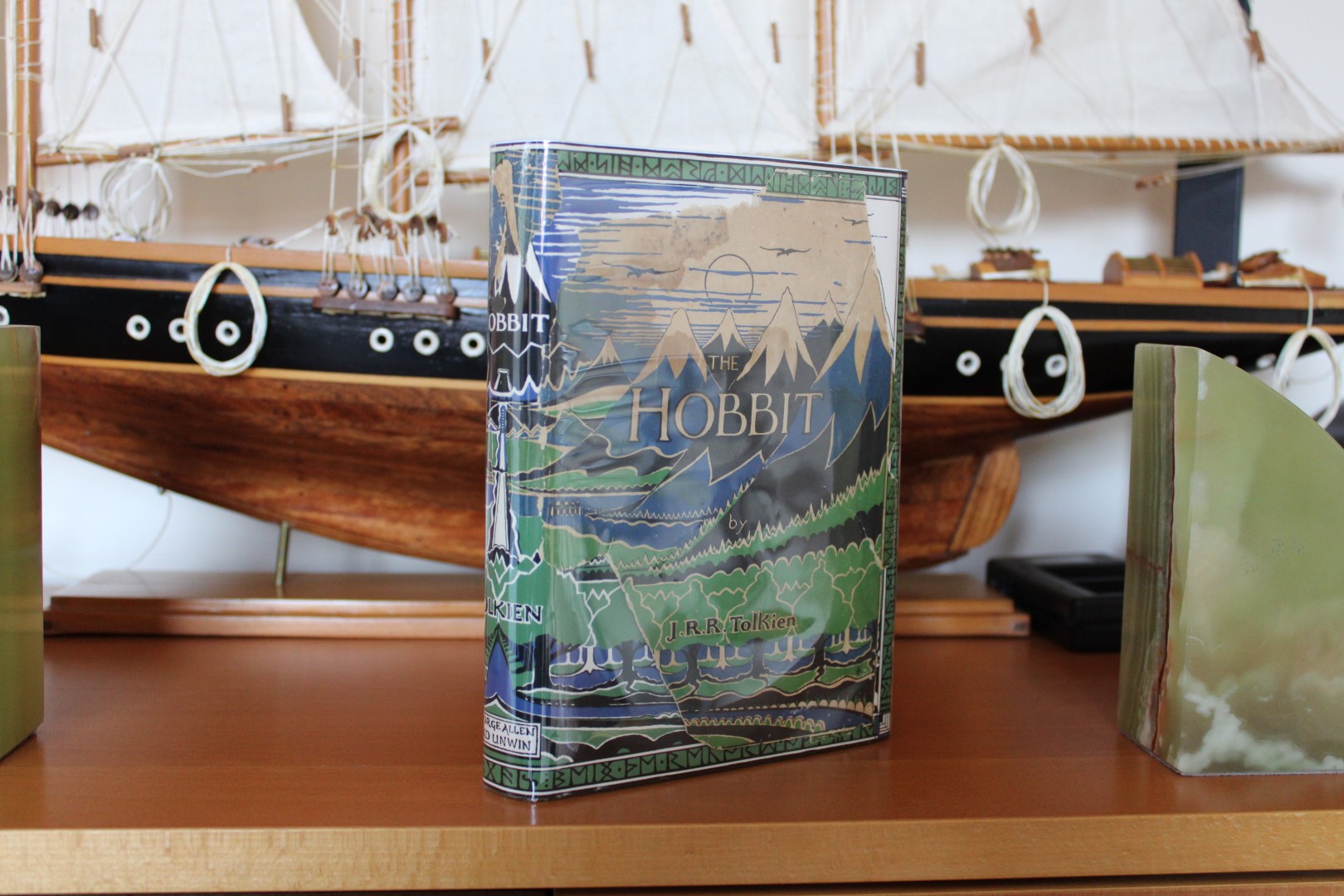
2nd impression Dust-jacket, parts of my dust-jacket in front of a facsimile jacket
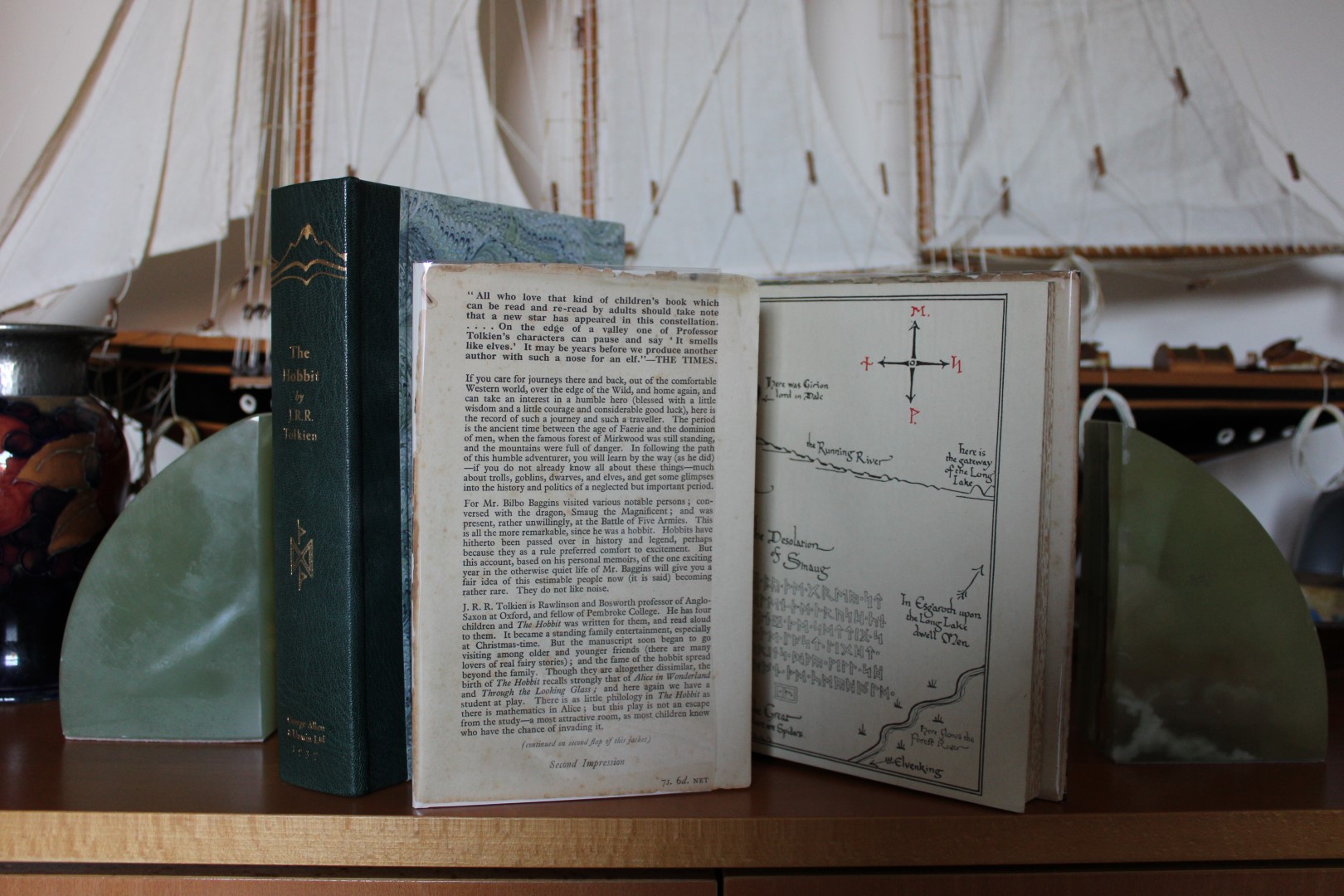
2nd impression Dust-jacket Blurb
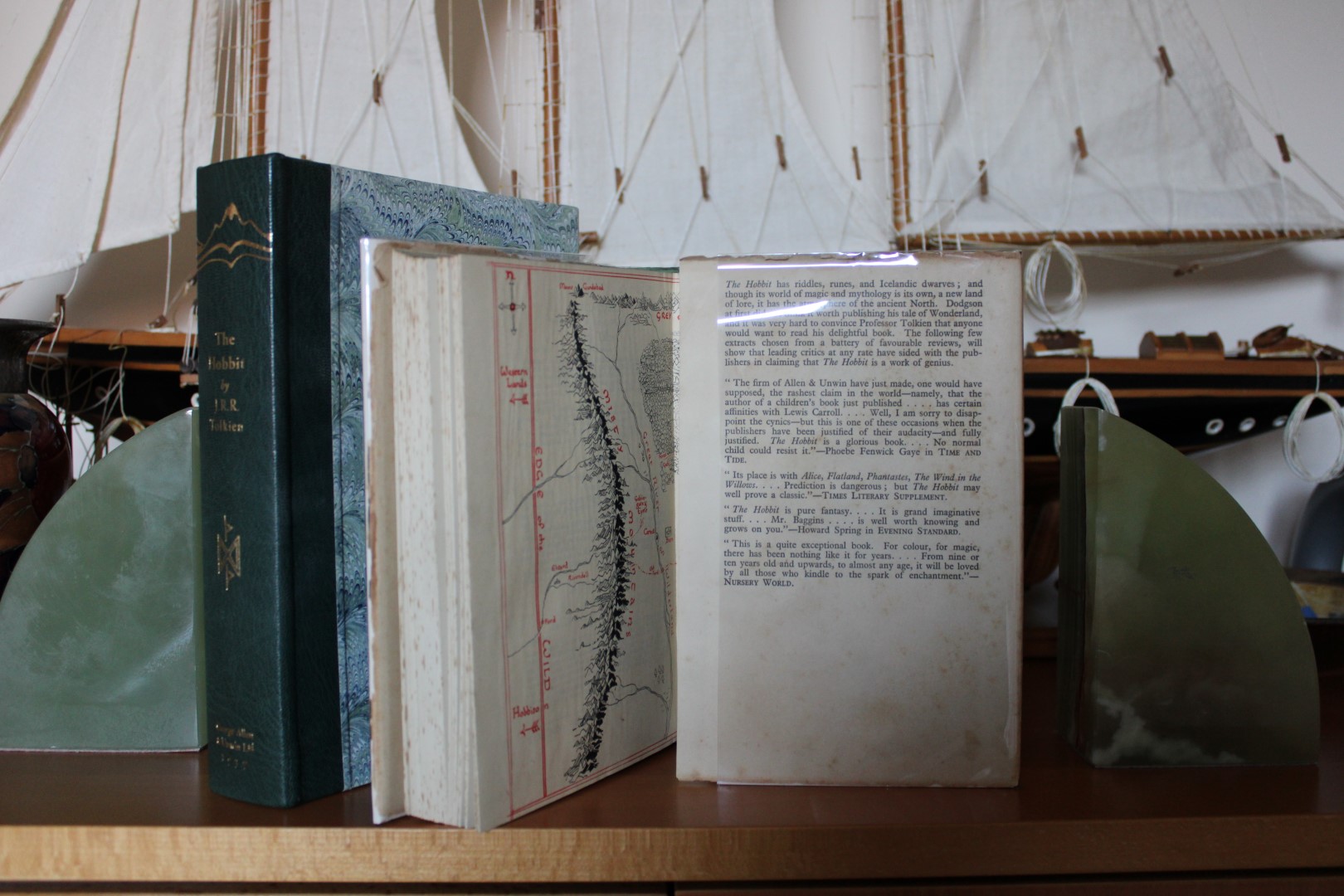
2nd impression Dust-jacket Blurb
Tolkien made suggestions for the dust-jacket blurb for this edition, Carpenter #15: Letter from J.R.R. Tolkien to C.A. Furth (Allen & Unwin) • 31 August 1937 (#15), as he was not happy with the 1st impression blurb. However, the blurb was switched back for the 3rd-5th editions, to the 1st impression blurb. I have included a link to the TCG forum post, at the end of this article, on the blurb textual changes.
This edition includes some coloured illustrations which were produced by Tolkien for possible inclusion in the Houghton Mifflin US edition.
These are
- The Hill: Hobbiton across the Water (the 1st printing Black & White version was removed)
- Rivendell: The fair valley of Rivendell
- Bilbo comes to the Huts of the Raft-elves: The dark river opened suddenly wide
- Conversation with Smaug: "O Smaug, the Chiefest and Greatest of all Calamities!"
The illustrations are labelled with the second description, which looks like confusion at the printers. When Tolkien supplied the images such as Bilbo comes to the Huts of the Raft-elves he included the illustration title as part of the illustration, but he also included a reference for the printer as to which page it should appear next to, in this case page 192, which features the text The dark river opened suddenly wide. The printers used this as the title of the illustration, and it also appears on the list of illustrations at the start of the book.
Apart from The Hill, most of these colour illustrations did not appear in the UK editions again until the 3rd Edition in 1966.
This edition is also the last time that the Black & White illustration Mirkwood was included.
2,323 copies were printed, but 423 copies were destroyed on the 7th November 1940, when a WW2 bomb hit the Edmonton warehouse of Key & Whiting, George Allen & Unwin's principal book-binder.
1942 George Allen & Unwin 3rd impression
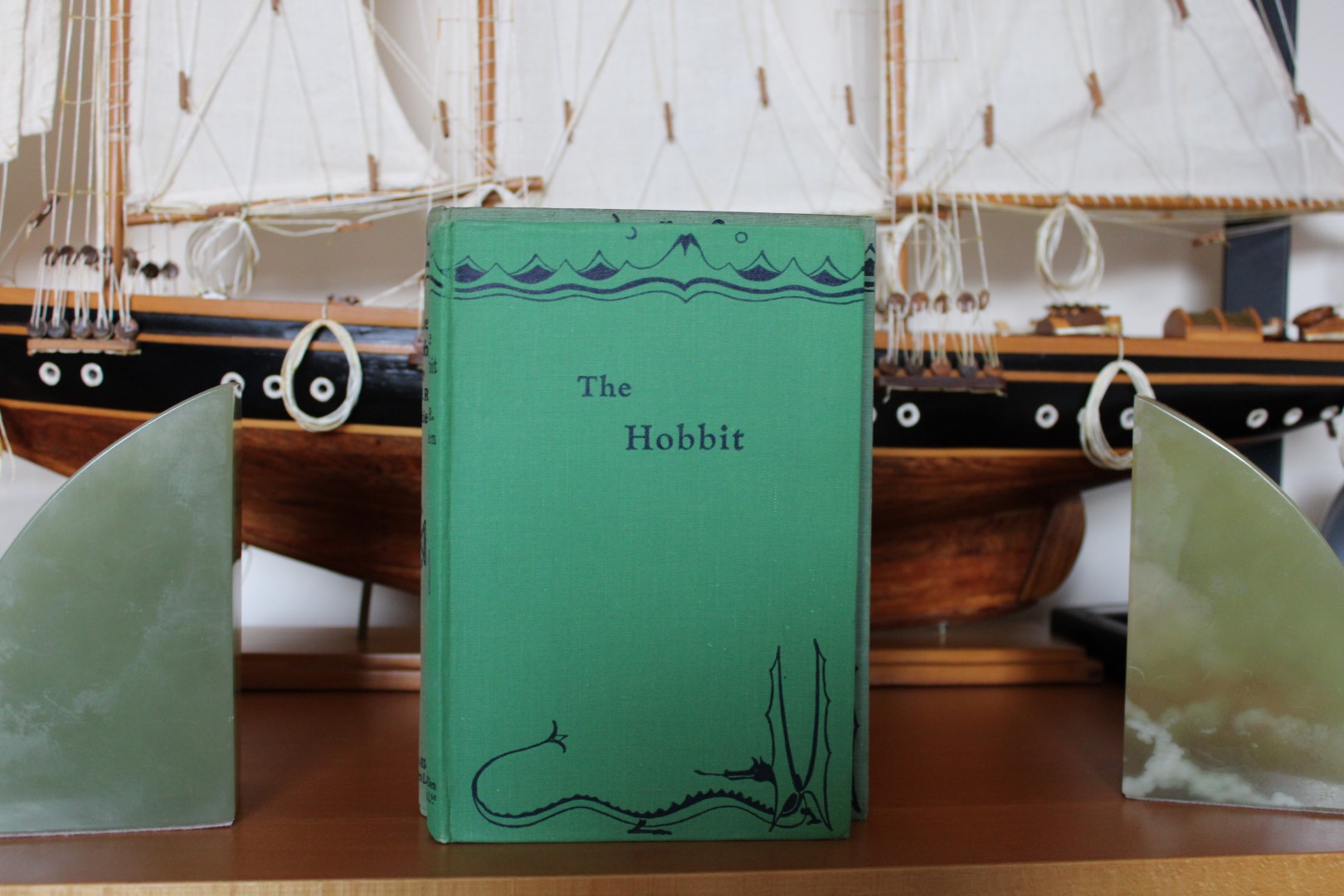
Resized book 2nd impression (at back) and 3rd impression
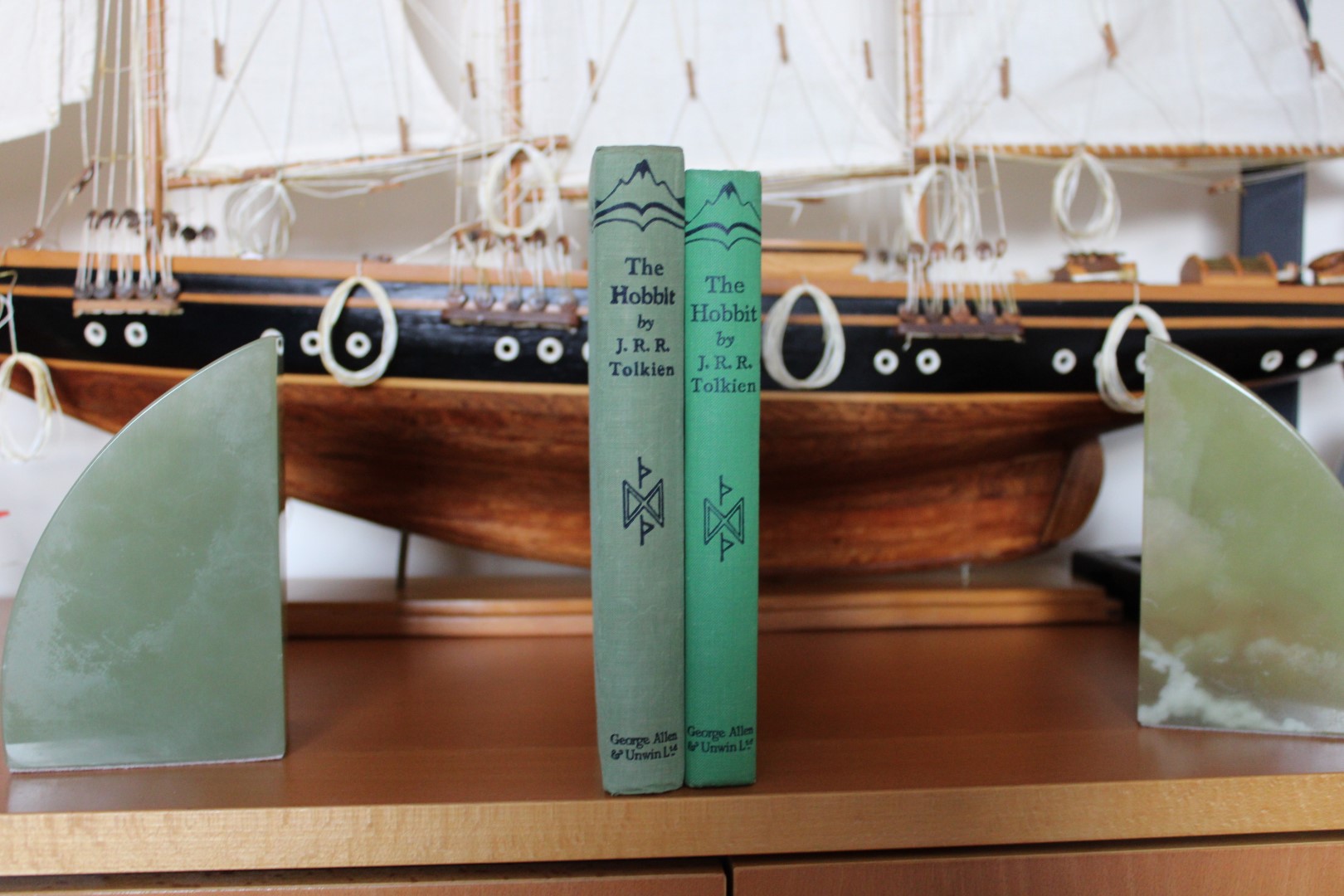
Resized book 2nd impression (left) and 3rd impression (right)
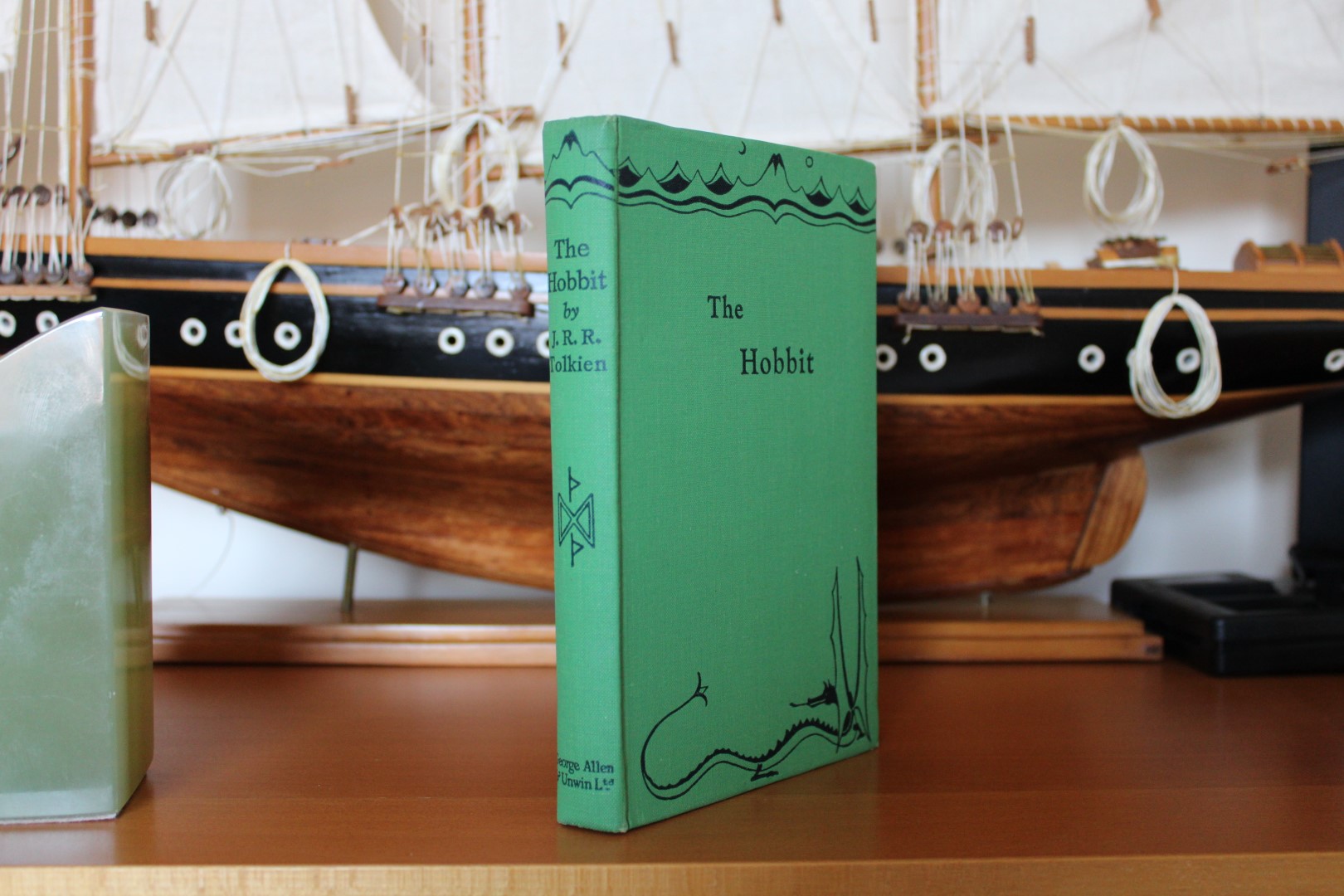
Binding of the 3rd impression
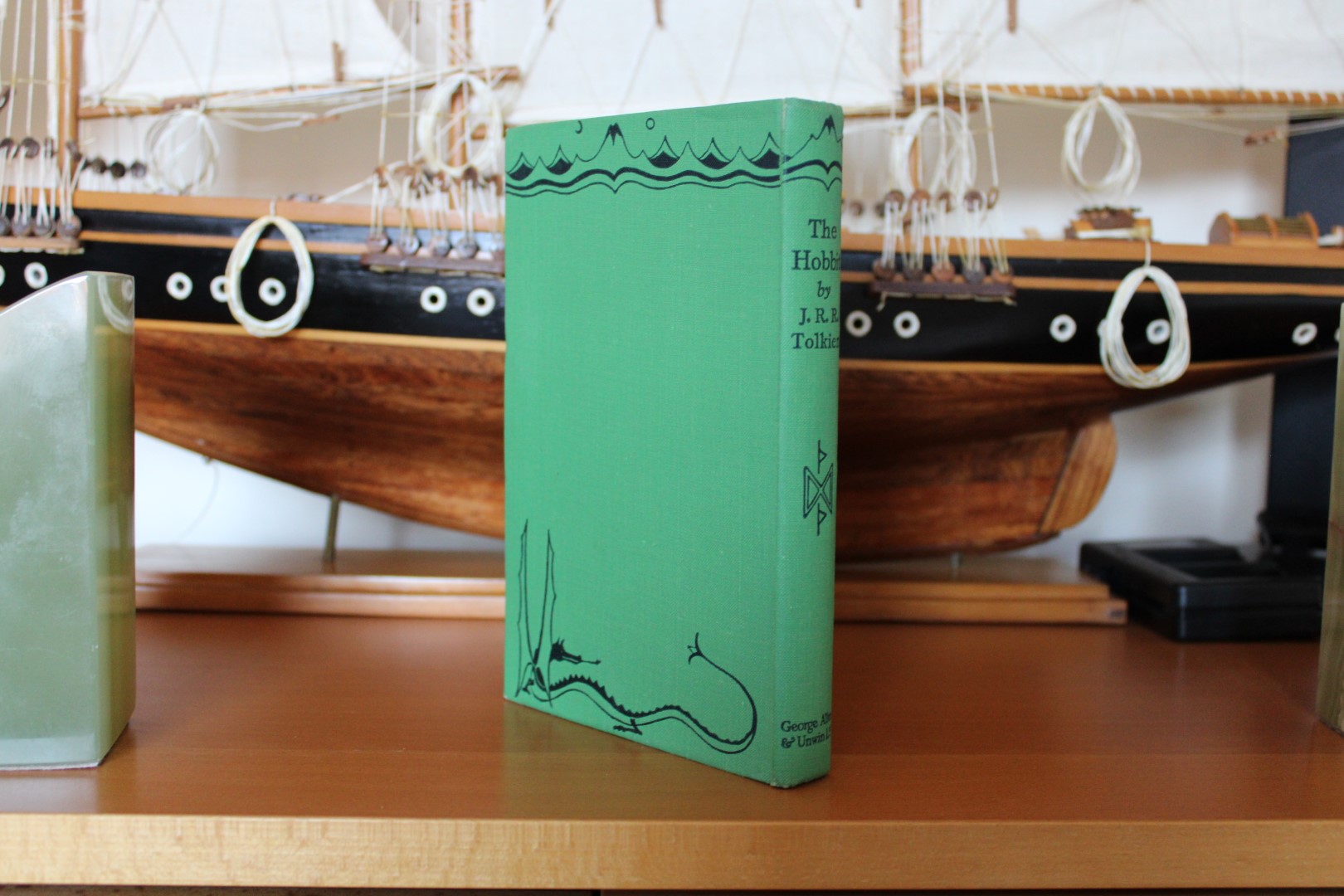
Binding of the 3rd impression
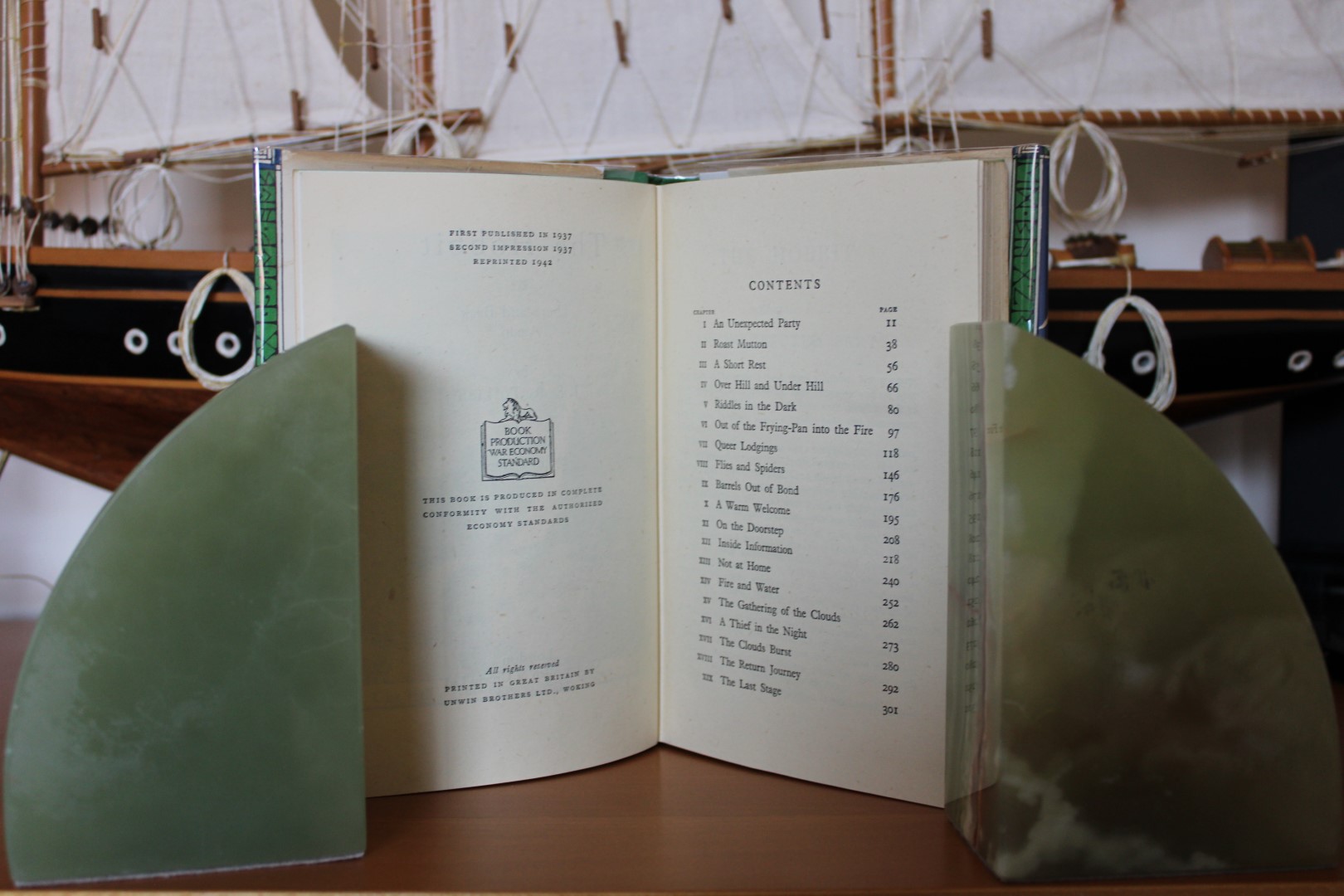
3rd impression Copyright Page
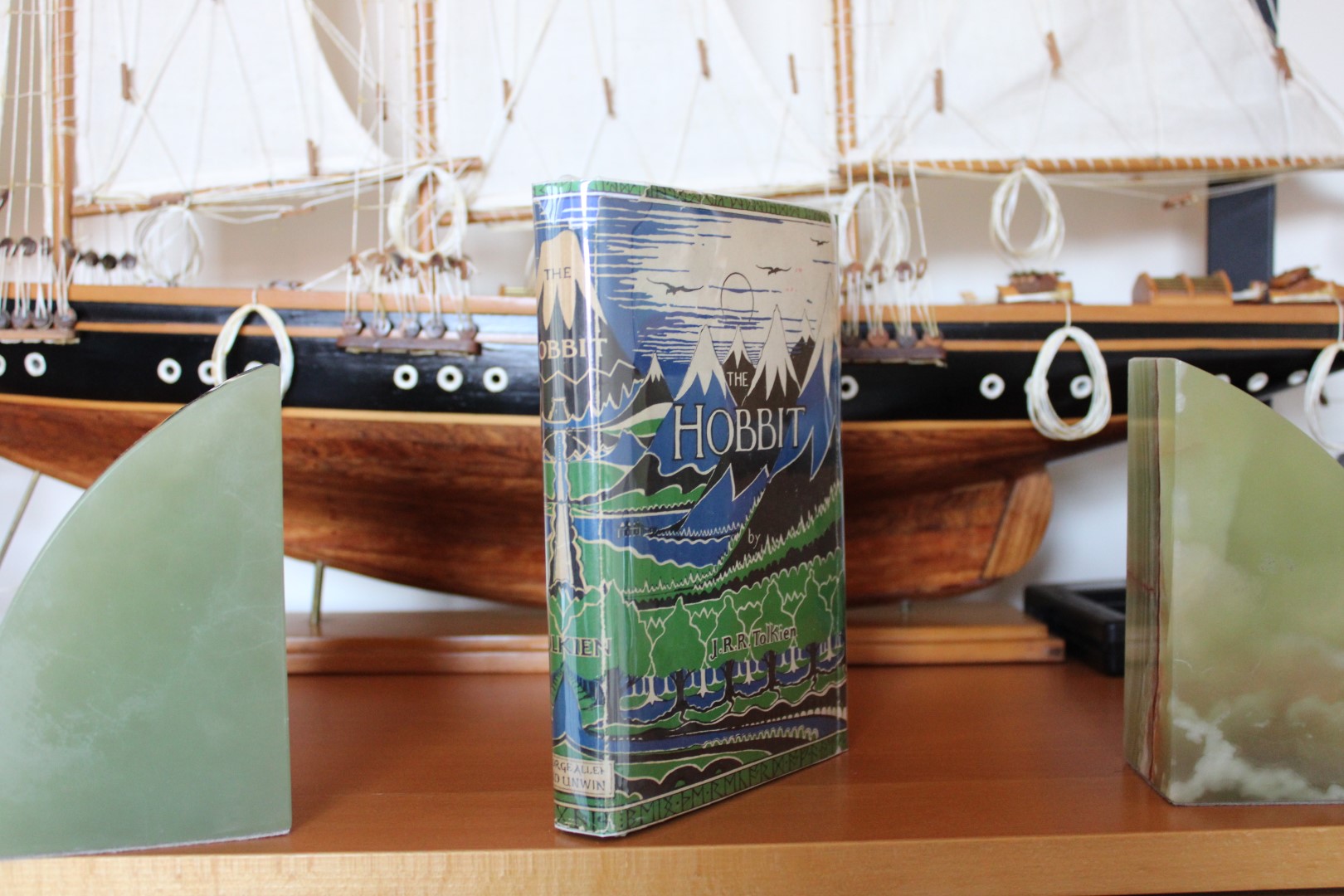
3rd impression Dust-jacket
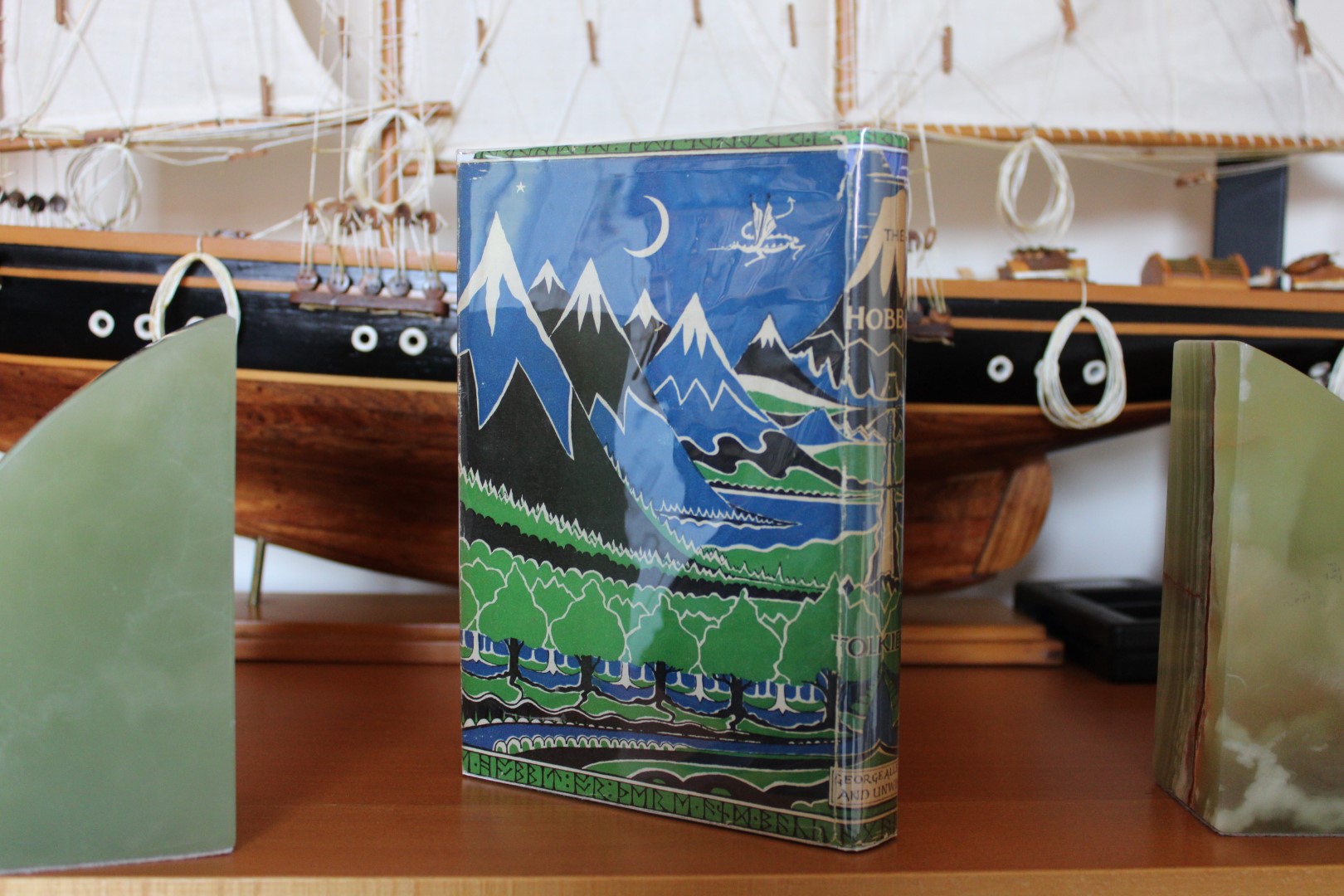
3rd impression Dust-jacket
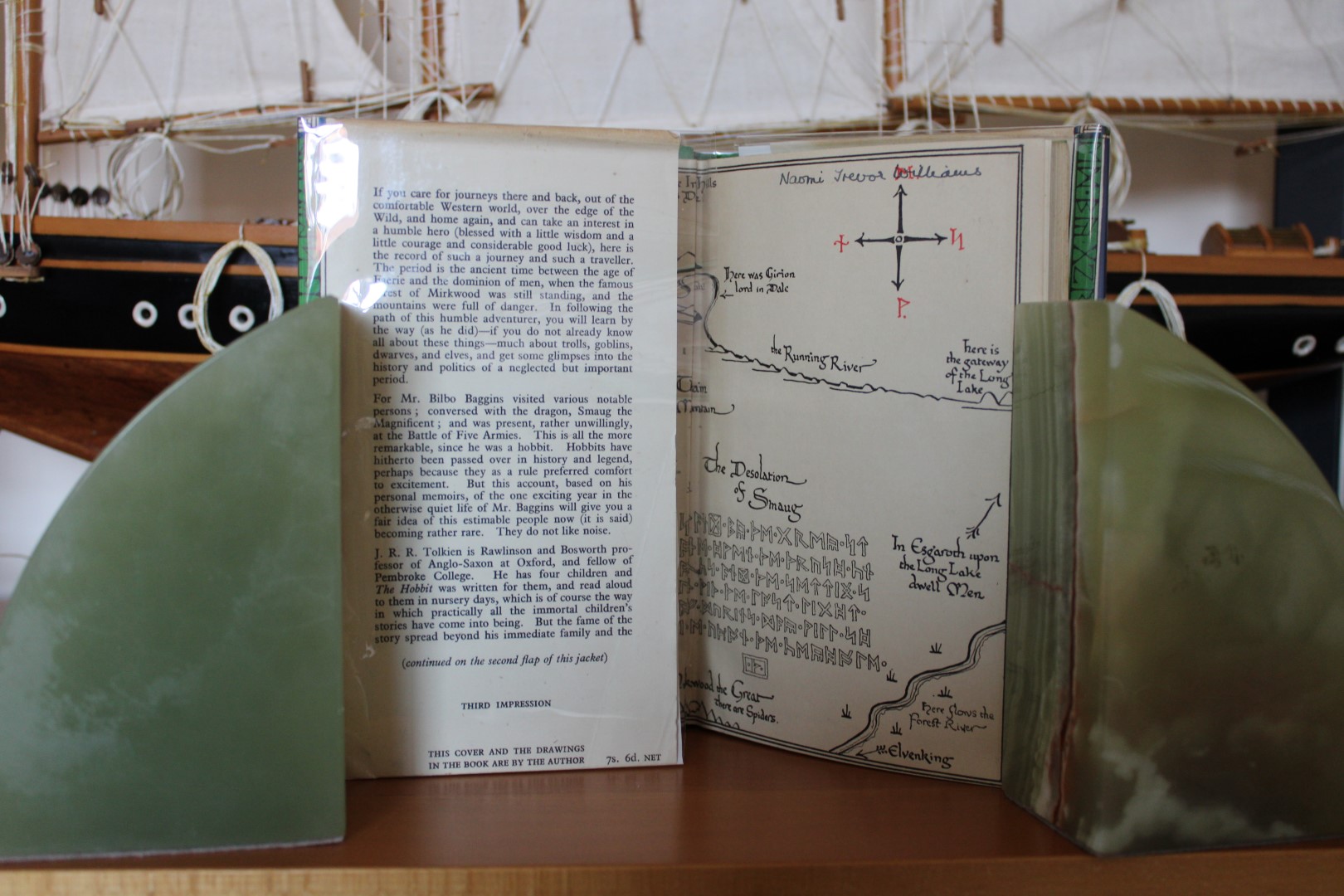
3rd impression Dust-jacket Blurb
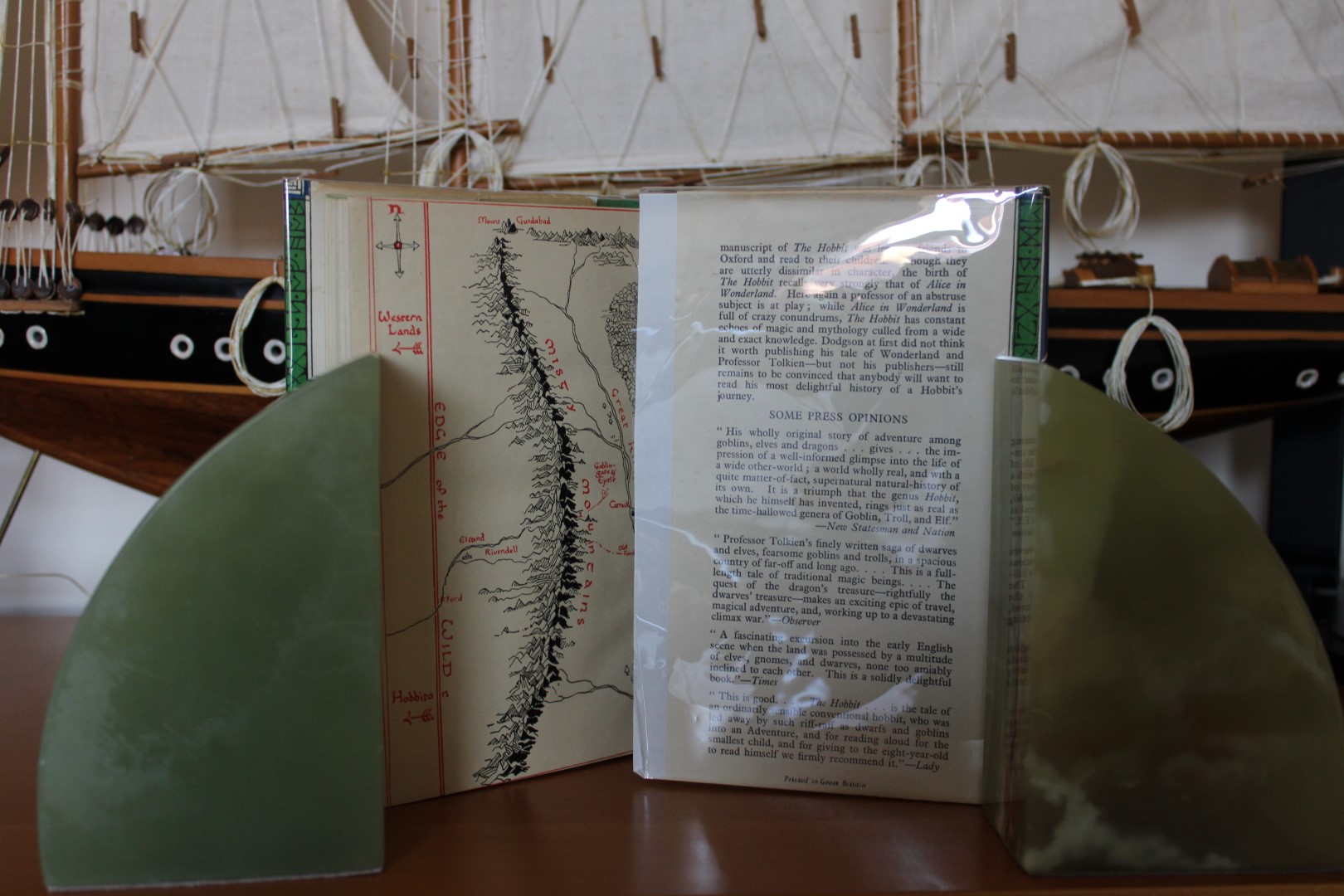
3rd impression Dust-jacket Blurb
1,509 copies bound as a War Economy Standard book. The Book Club edition and the 1946 4th Impression were also printed to the same specifications.
The need to conserve paper in Britain during World War II led to rationing from 1940 with Publishers having their paper supplies cut to 60% of their pre war usage. The 'Book Production War Economy Agreement' of 1942 between the Ministry of Supply and the Publishers Association bought in codes governing the production of books with strict guidelines covering print size, words per page, blank pages and so on. Whilst it was a voluntary agreement Publishers who didn't join had their already rationed paper supply cut further. Despite the limitations placed on publishing during the War demand for books grew, especially amongst the less wealthy echelons of society. Paper rationing in Britain continued until 1949.
BBC Article, link at bottom of page
As can be seen from the size comparison between the 1937 and 1942 edition, the book was cut-down in size. This also meant that the dust-jacket was reduced in size and it appears the printers could not use the new size without losing some of the original jacket, the runes at the top and bottom of the dust-jacket are no longer complete. They are also now printed onto dust-jacket flaps instead of the front and rear dust-jacket cover. The colour of the cloth binding was also changed from teal to green.
The only colour illustration to remain was the frontispiece, The Hill.
1942 Foyle's Children's Book Club edition
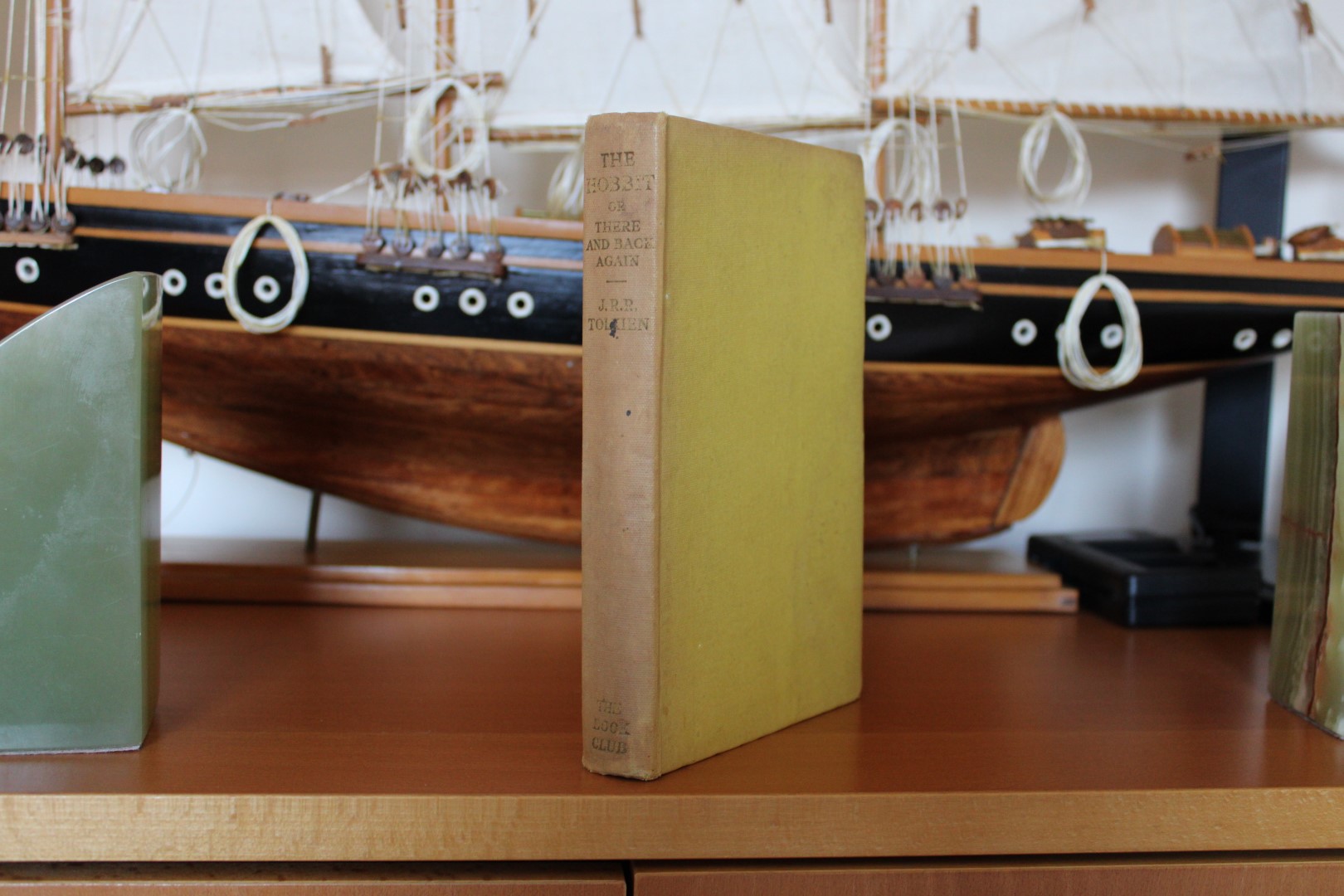
Binding of the Book Club edition
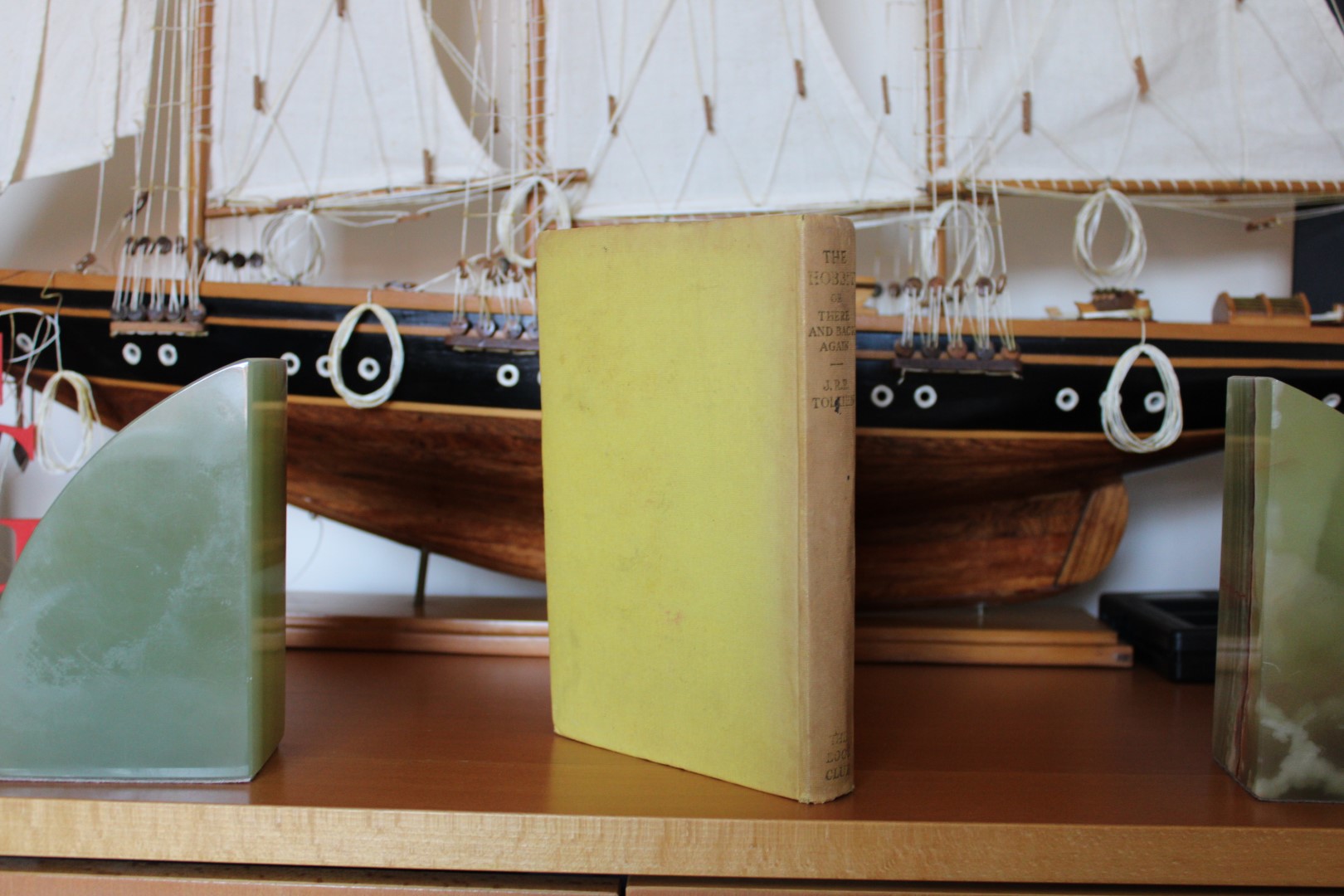
Binding of the Book Club edition
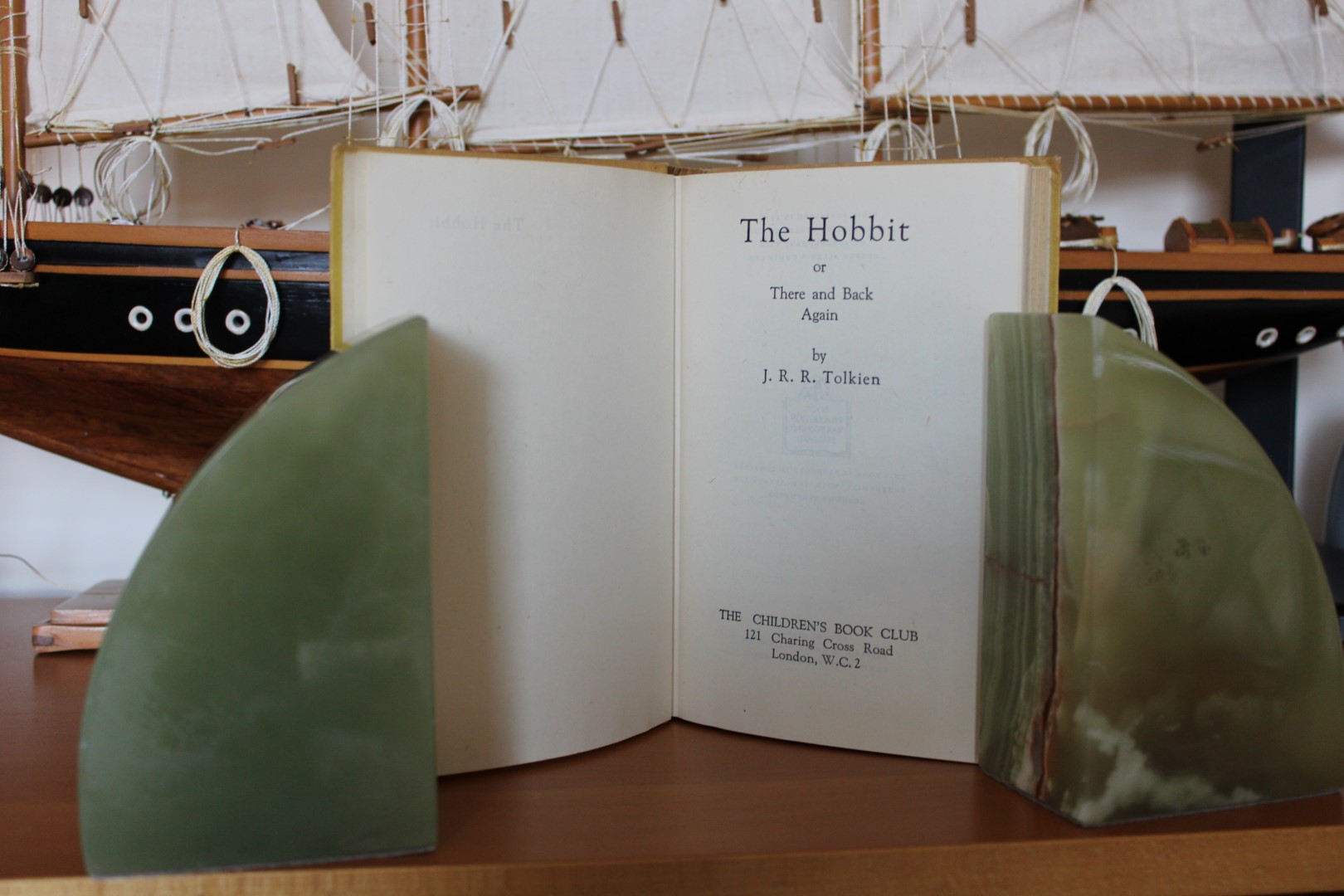
Book Club edition Title Page
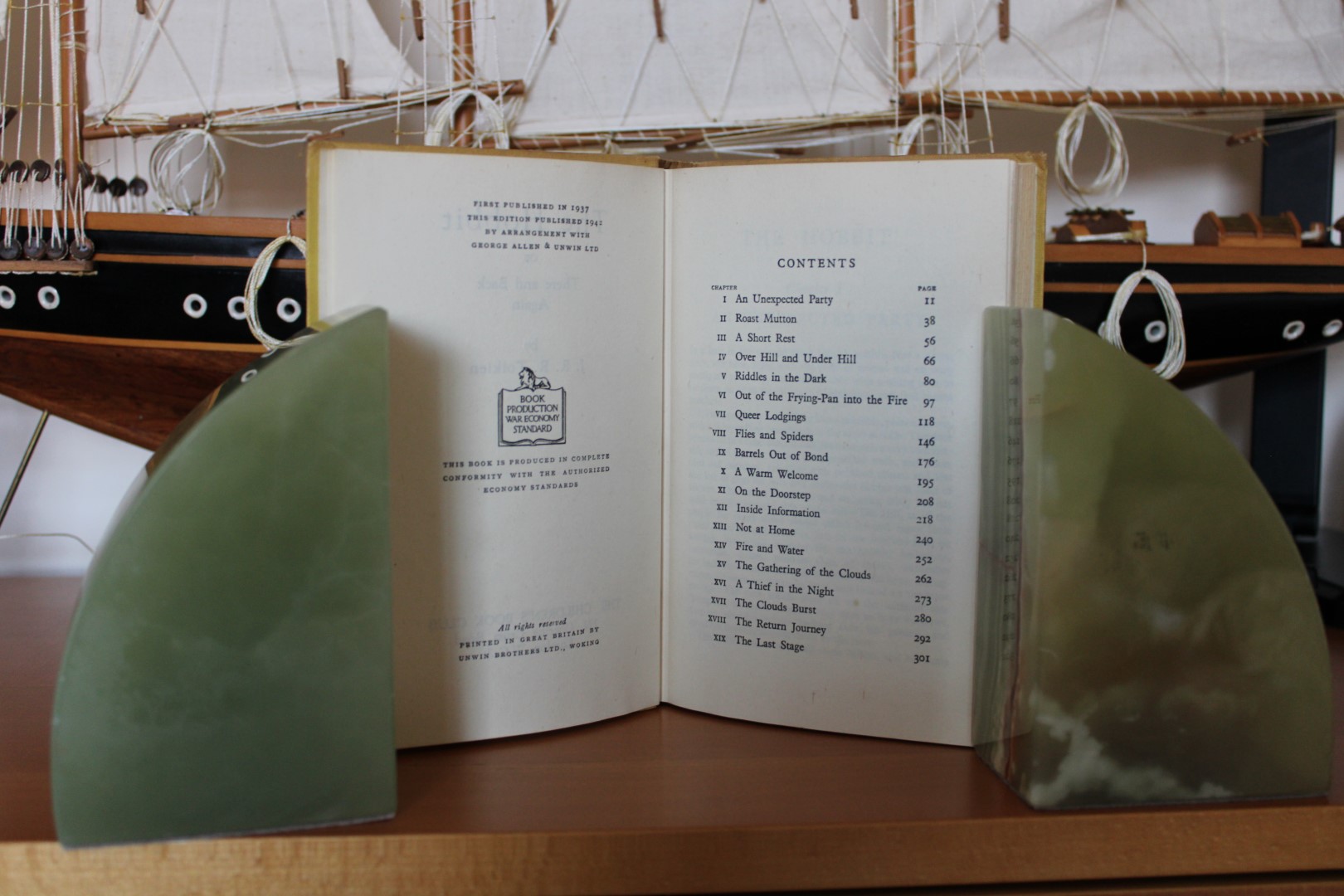
Book Club edition Copyright Page
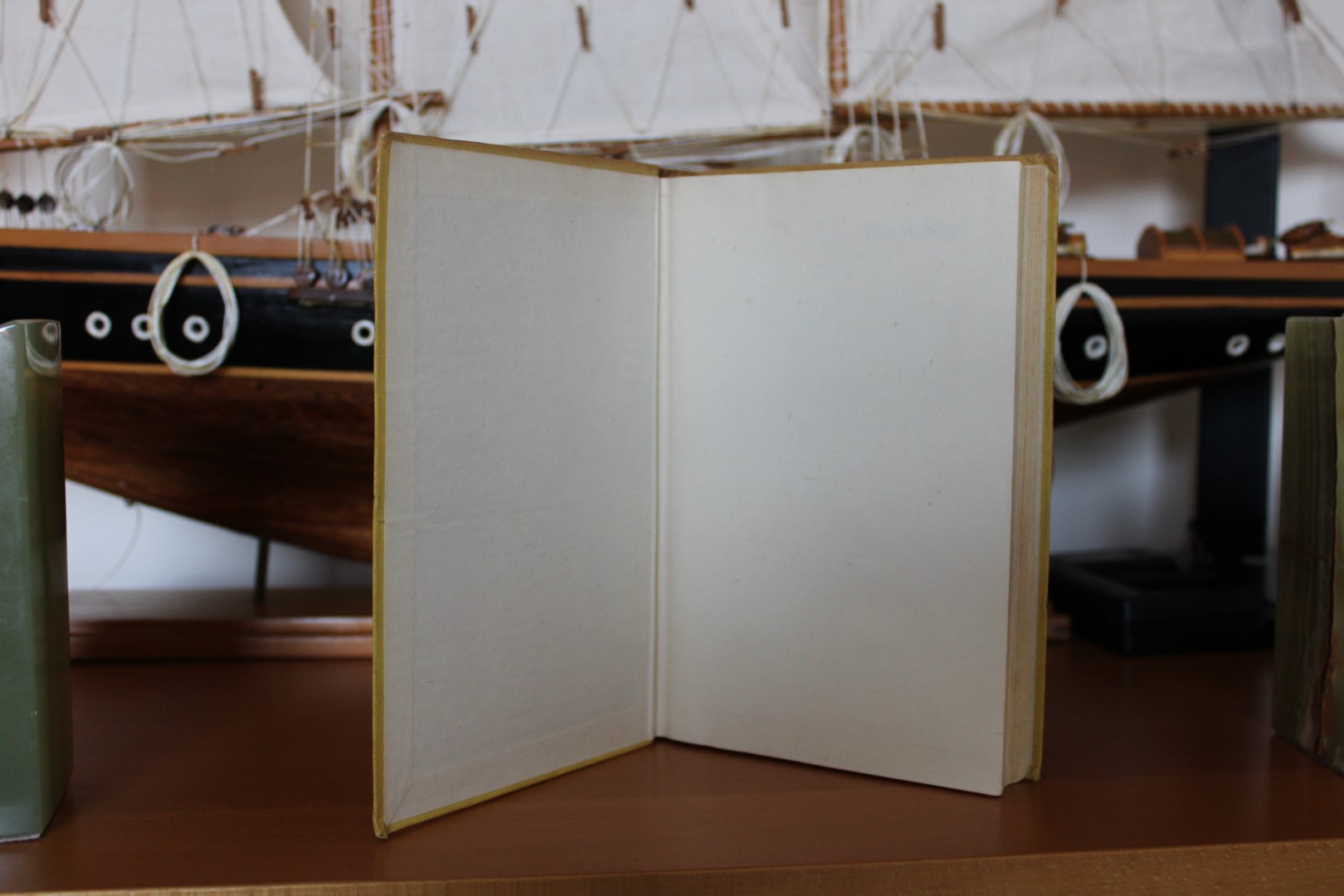
Book Club edition blank Endpaper, no maps included
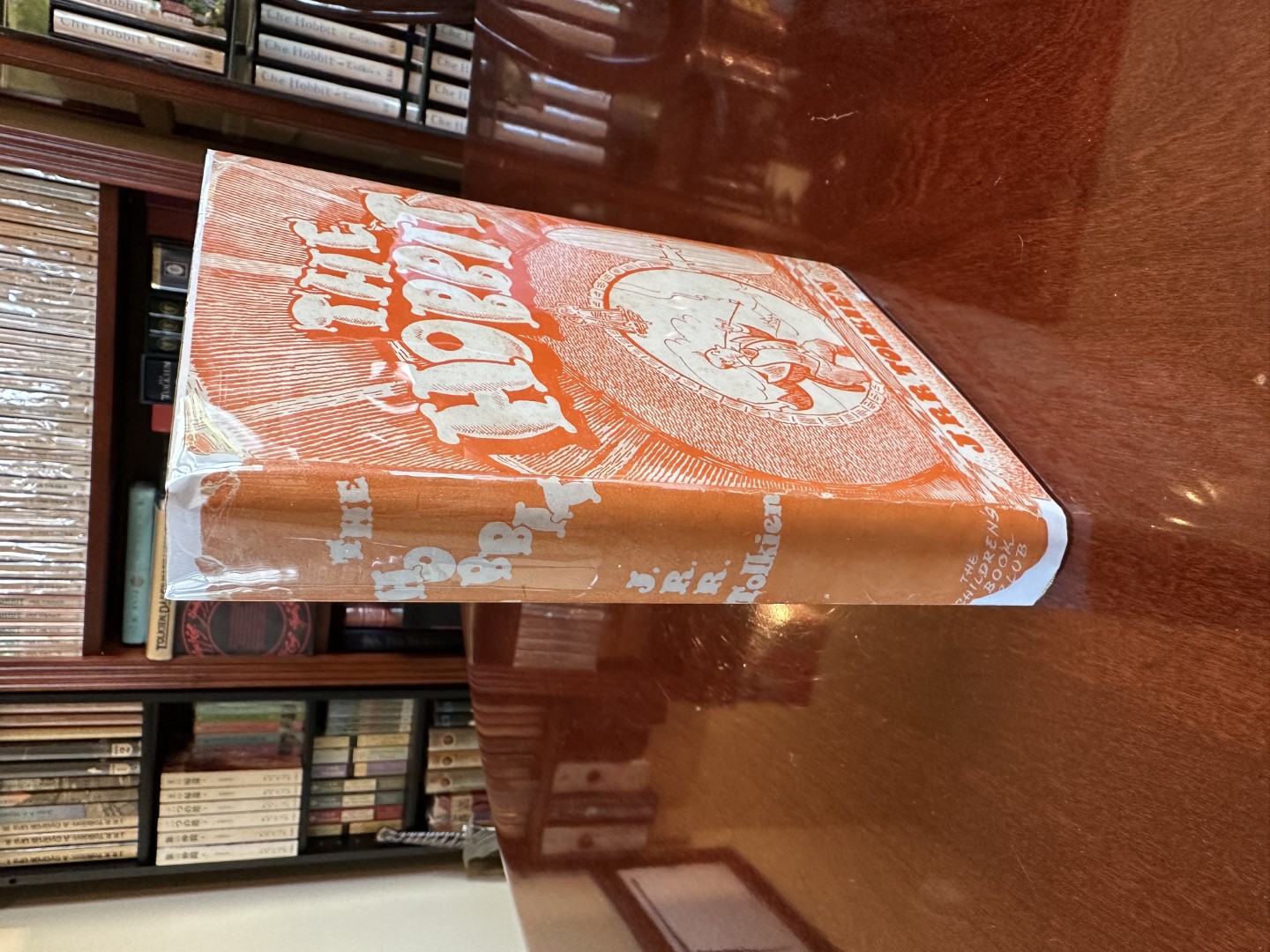
Book Club edition Dust-jacket (LanceFormation)
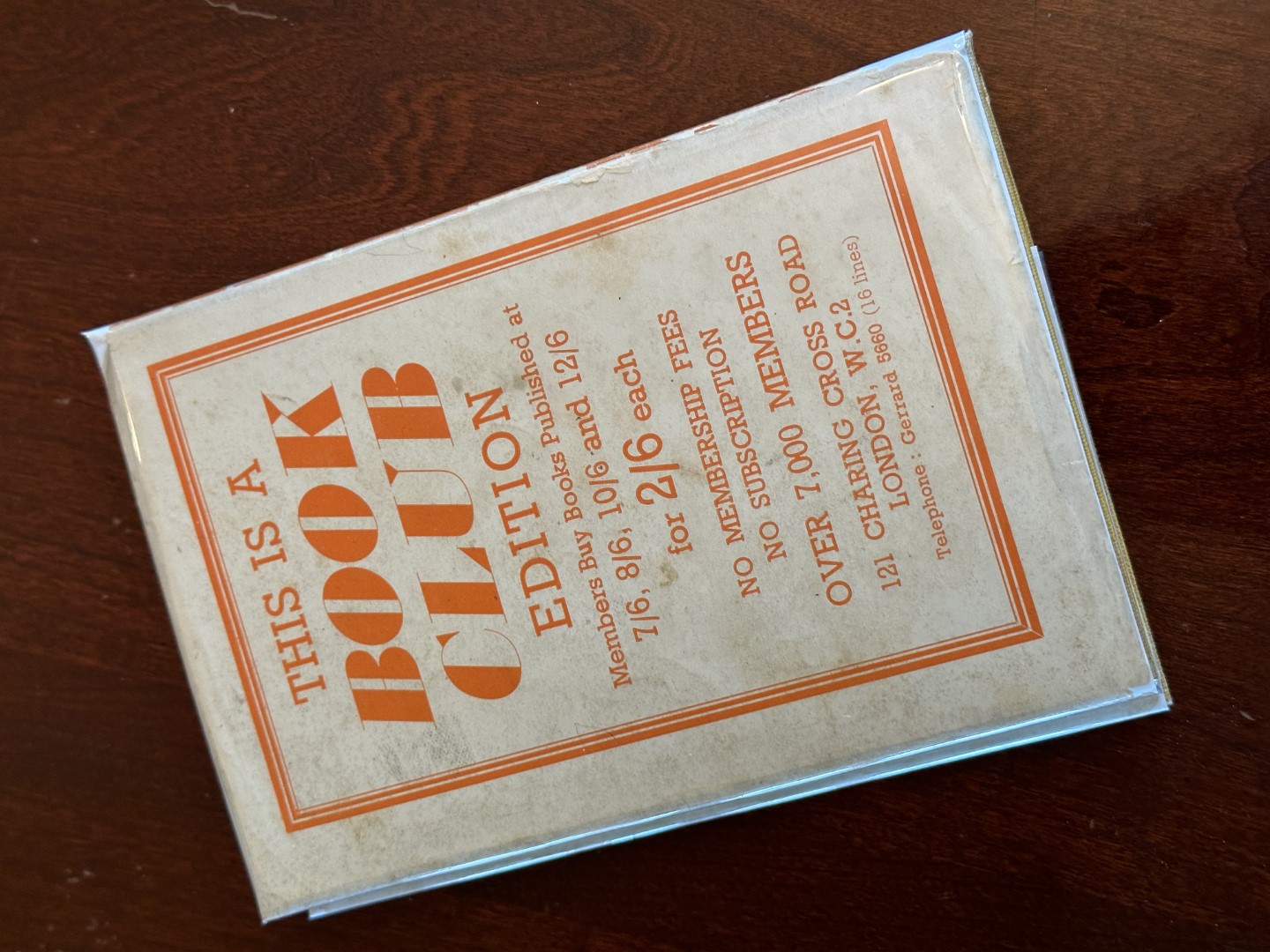
Book Club edition Dust-jacket (LanceFormation)
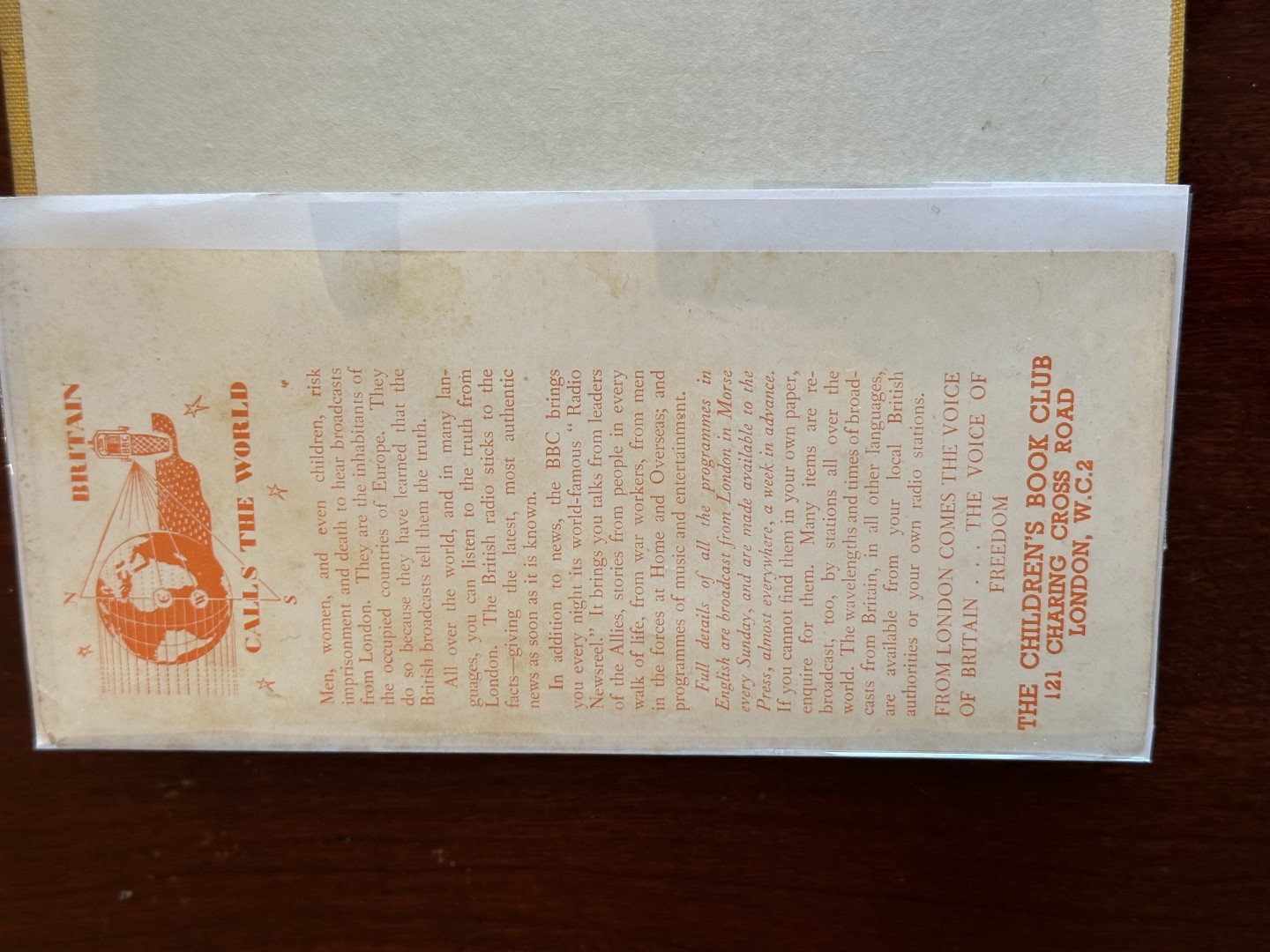
Book Club edition Dust-jacket Blurb (LanceFormation)
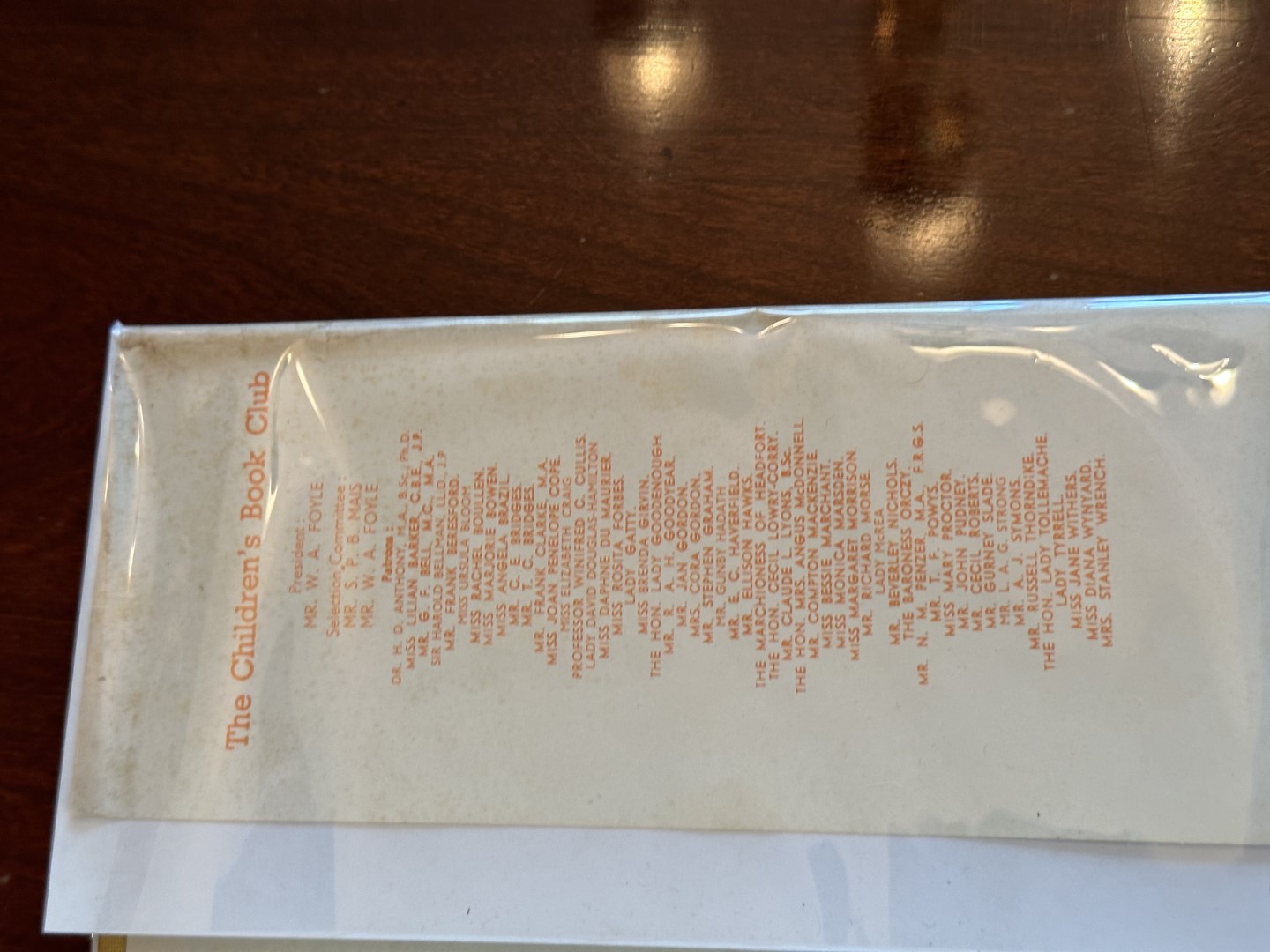
Book Club edition Dust-jacket Blurb (LanceFormation)
Foyle's Children's Book Club had there own paper rationing supply and agreed with George Allen & Unwin to print 3,000 copies of the Book Club edition, along with the 3rd impression. The Book Club edition retailed at 2s 6d., whilst the George Allen & Unwin retailed at 7s 6d, so these editions were considerably more affordable for the book buying public.
No colour illustrations and no maps on the endpapers were included which must have caused some confusion for readers when reading this sentence on page 30
(Look at the map at the beginning of this book, and you will see there the runes in red.)
Bilbo on the dust-jacket reminds me of P.G. Wodehouse's Bertie Wooster and unsuprisingly Tolkien was not enamoured of the orange dust-jacket.
In Carpenter #98: Letter from J.R.R. Tolkien to Stanley Unwin • Undated (circa 18 March 1945) (#223), Tolkien wrote
Surely the paper wasted on that hideous dust-cover could have been better used.The Annotated Hobbit, Revised and Expanded Edition, Douglas A. Anderson, p. 384[1]
The other striking thing about this edition, is that it really gives no clue, in the dust-jacket blurb, as to what the book is about. Instead it details why you should only listen to the BBC Radio for news.
1946 George Allen & Unwin 4th impression
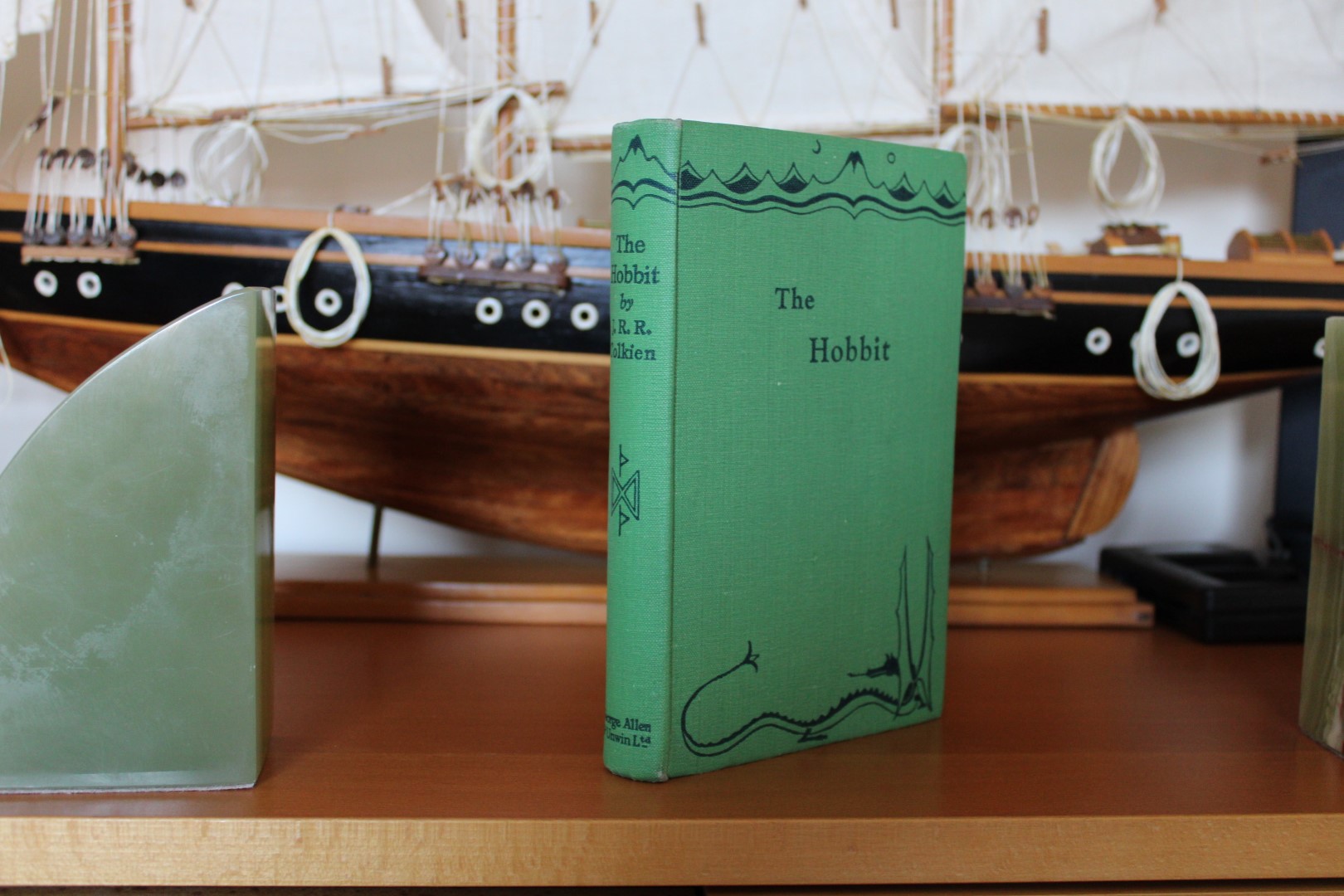
Binding of the 4th impression
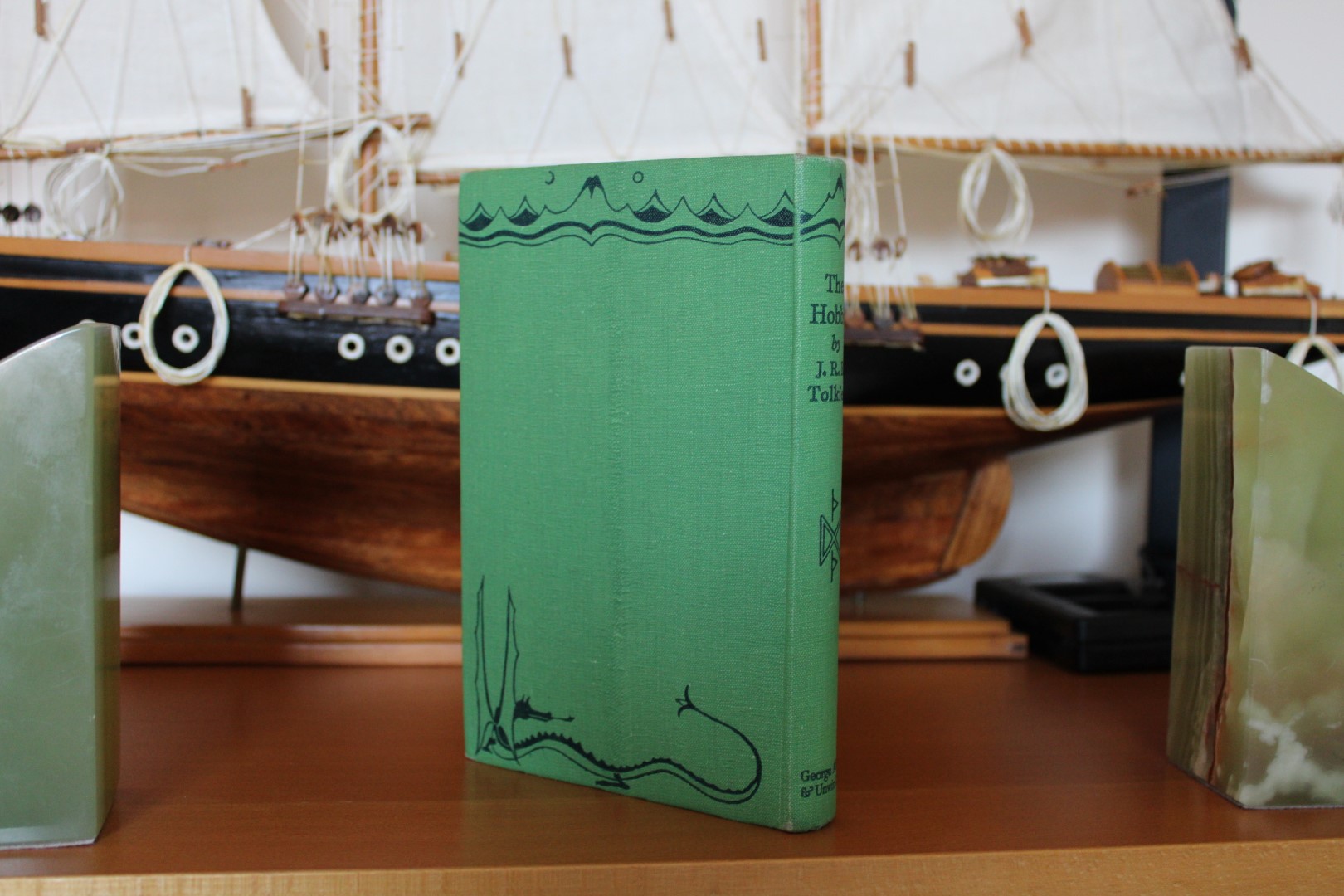
Binding of the 4th impression
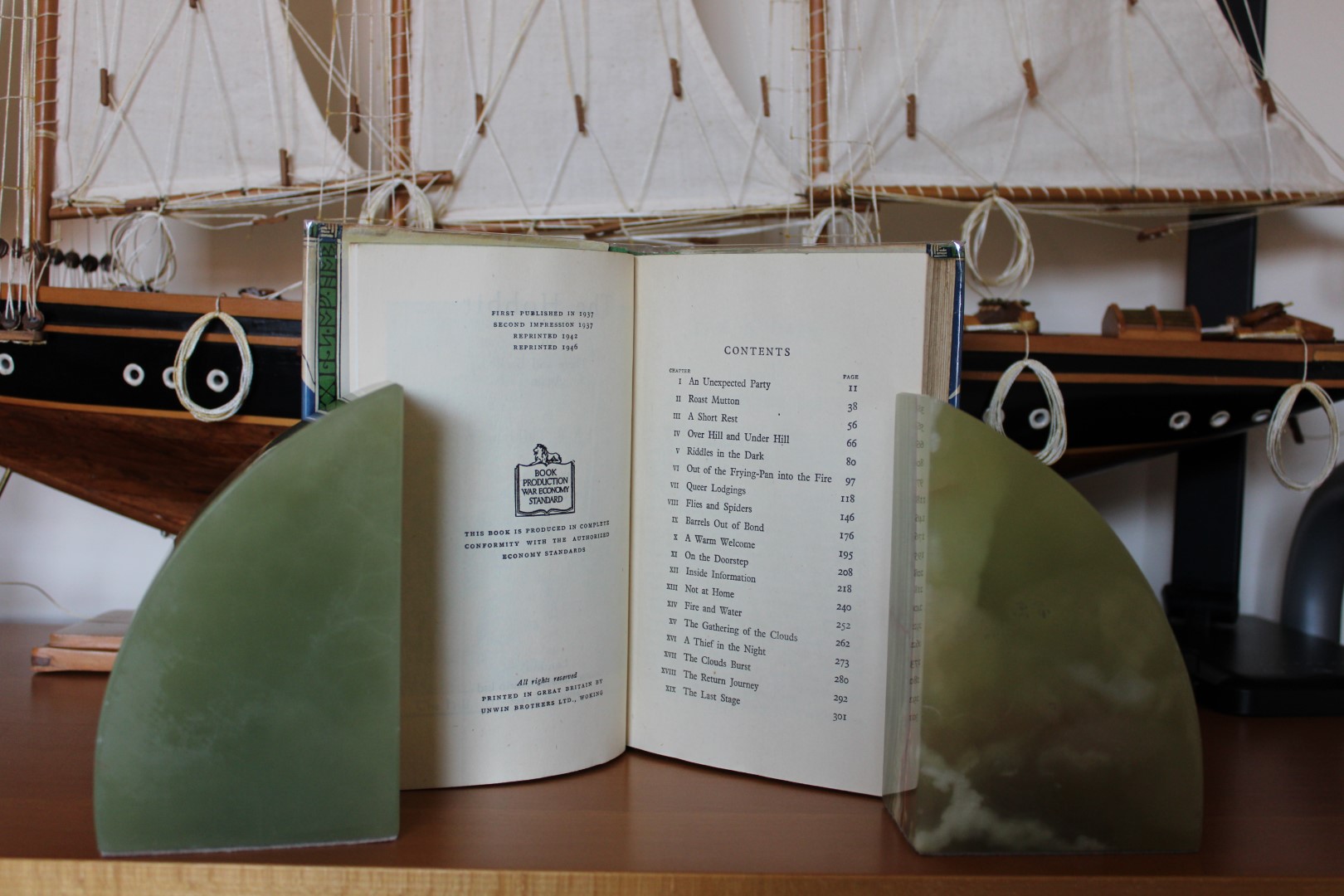
4th impression Copyright Page
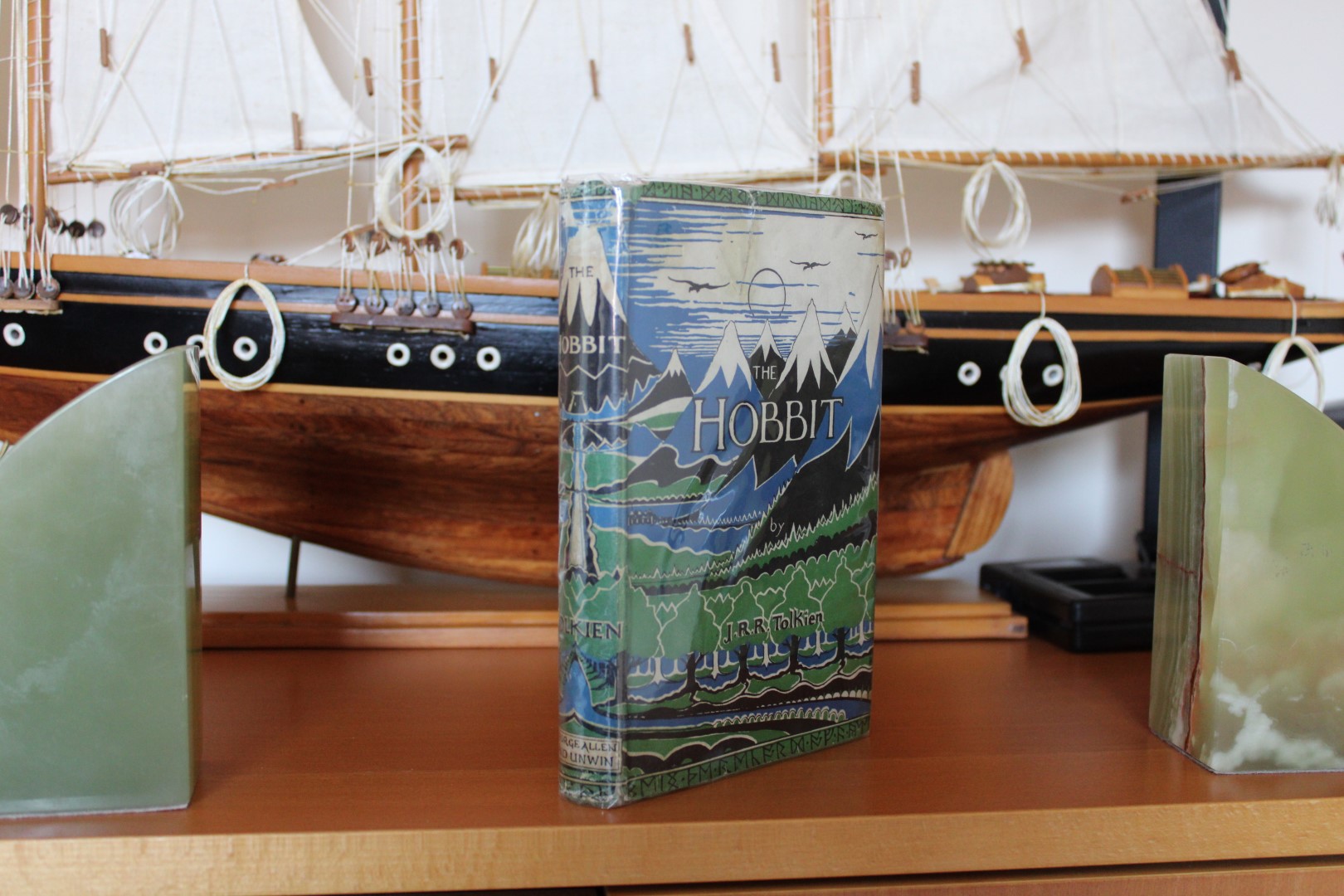
4th impression Dust-jacket
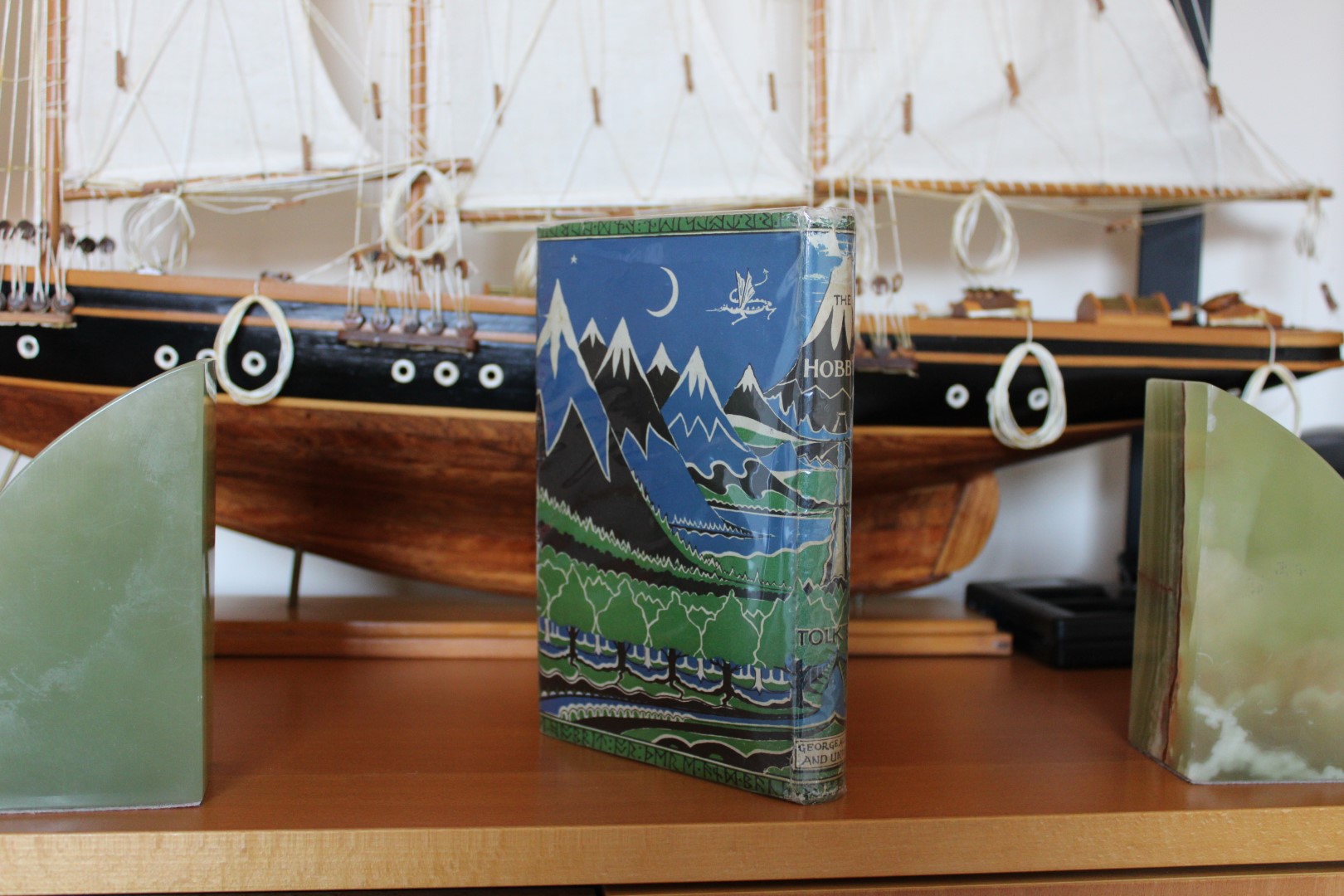
4th impression Dust-jacket
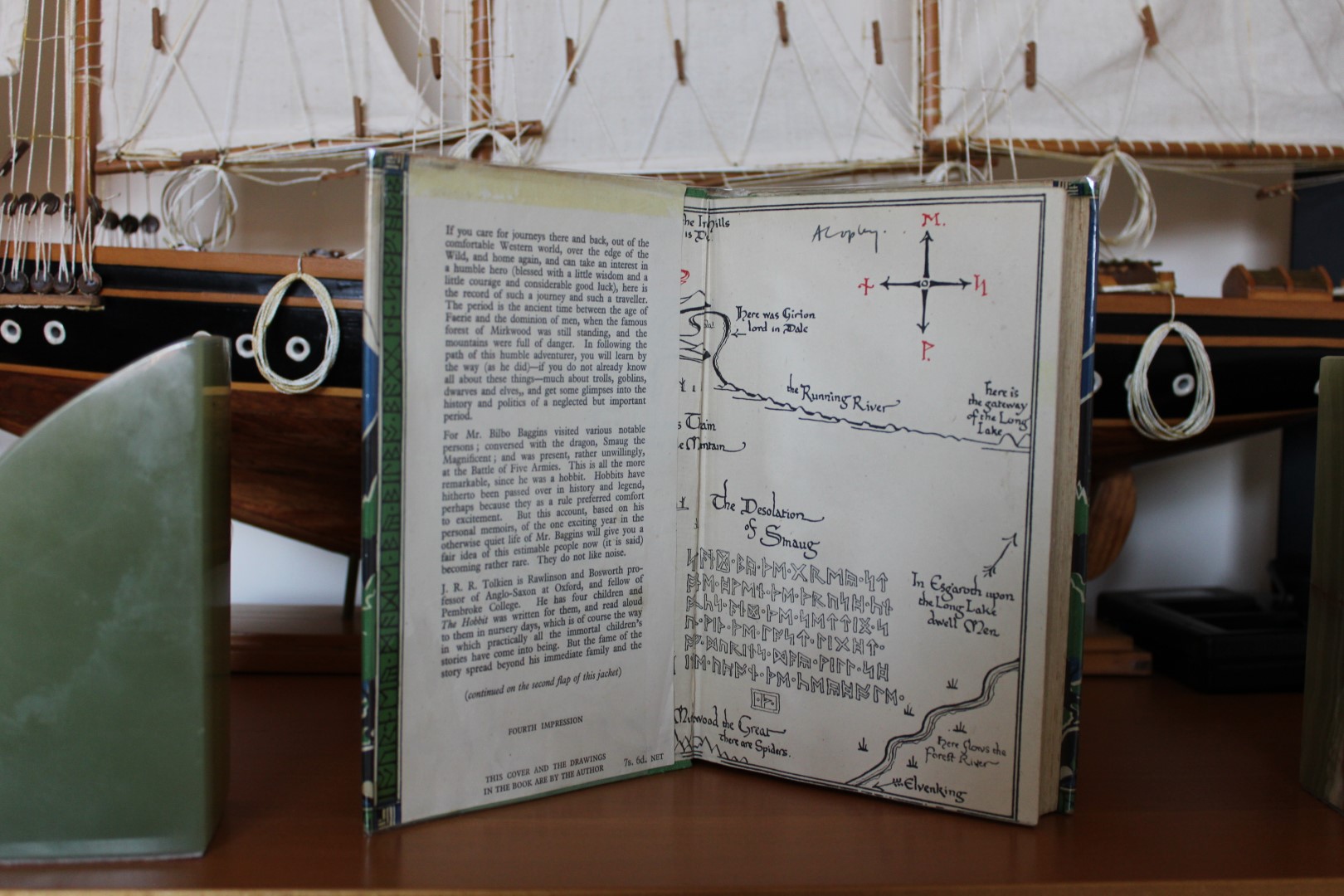
4th impression Dust-jacket Blurb
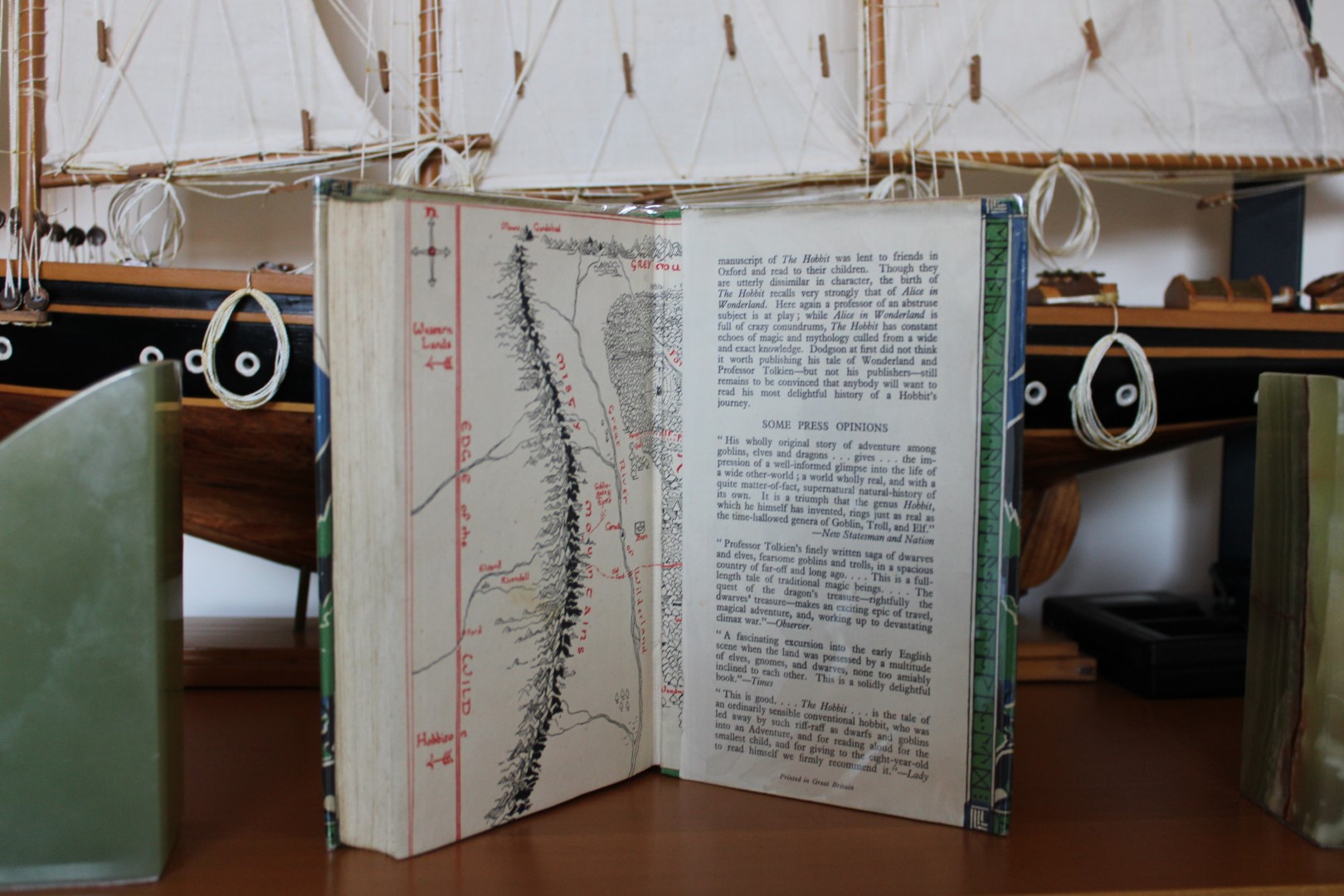
4th impression Dust-jacket Blurb
4,032 copies bound. This edition is seemingly identical to the 1942 George Allen & Unwin printing. This was the last UK printing of the first edition text of The Hobbit.
1947 Kooperativa förbundets bokförlag 1st impression
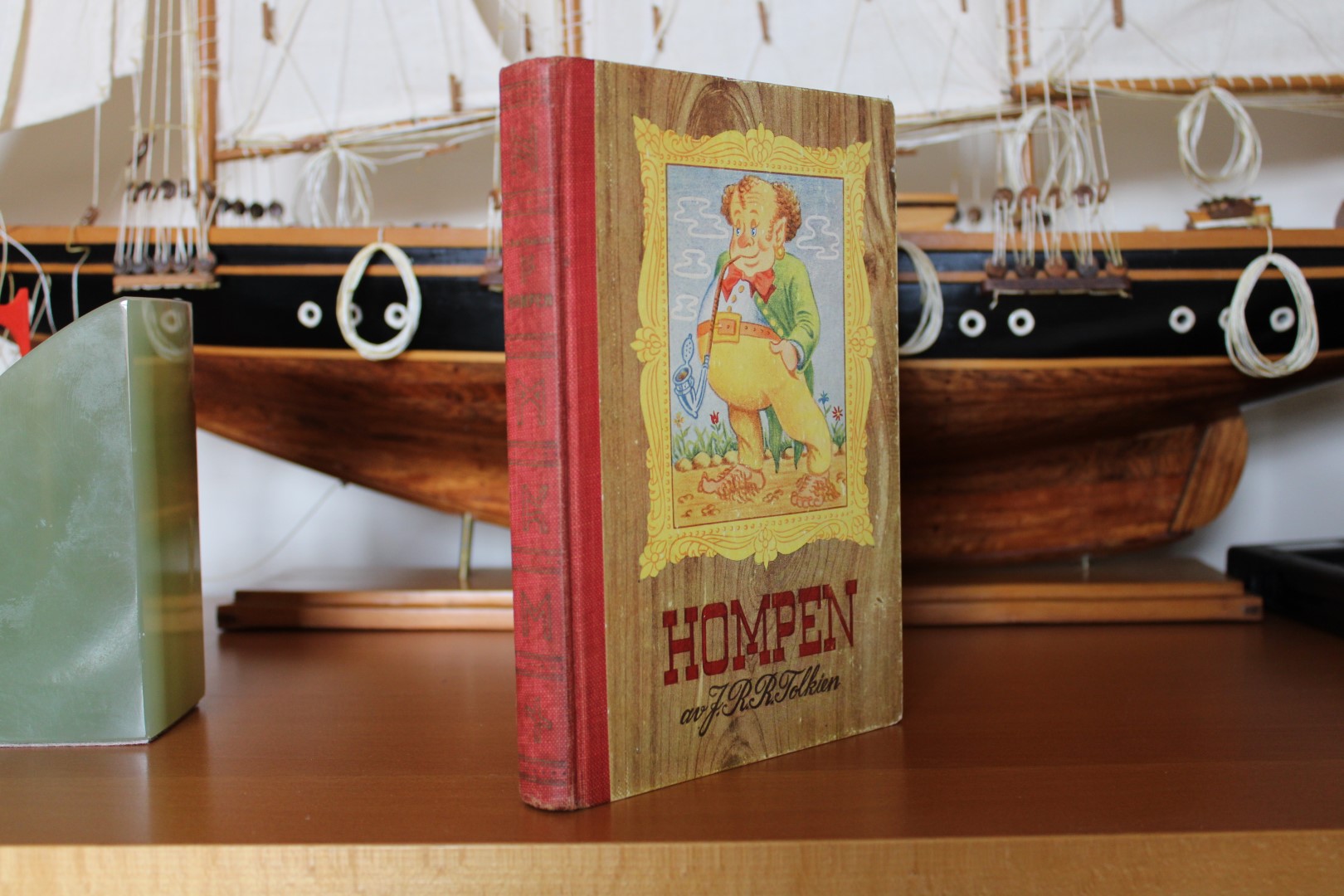
Hompen 1947
This is the only translation that I am aware of the first edition English text of The Hobbit. Would love to see an article on Swedish Hobbits from one of our members

Conclusion
The Hobbit has sold over 100 million copies and the UK first edition Hobbits are a great area to collect, but due to the huge interest in early Tolkien are now very expensive to acquire.
However, HarperCollins have released a facsimile edition of the 1937 George Allen & Unwin first printing, which is a great way to see what the original edition looked like. If you are interested in the facsimiles, then please see a TCG article linked below.
A very big thank you to LanceFormation for providing images for the dust-jackets of the UK 1st impression and the 1942 Foyle's Book Club Hobbit.
For more information
- J.R.R. Tolkien A Descriptive Bibliography - Wayne G. Hammond with the assistance of Douglas A. Anderson (Oak Knoll) - A3 page 4
- The Art of The Hobbit by J.R.R. Tolkien - Wayne G. Hammond & Christina Scull
- George Allen & Unwin A Remembrancer - Rayner Unwin
- The Annotated Hobbit - Douglas A. Anderson
- Deagol's Tolkienbooks.net - Printing and Binding Early Editions of The Hobbit https://tolkienbooks.net/php/earlyhobbits.php#1st
- BBC Book: 1943 - 'War Economy Standard' https://www.bbc.co.uk/ahistoryofthewor ... ts/gfVebUPGSTKuwMYgL0oIrg
TCG Hobbit Articles
- First Edition Hardback Hobbits (UK)
- First Edition Hardback Hobbits (US)
- US Second Edition Hobbits
- Facsimile Hobbits
- UK Hobbit Dust-jacket Blurb
- The Hobbit and other Stories















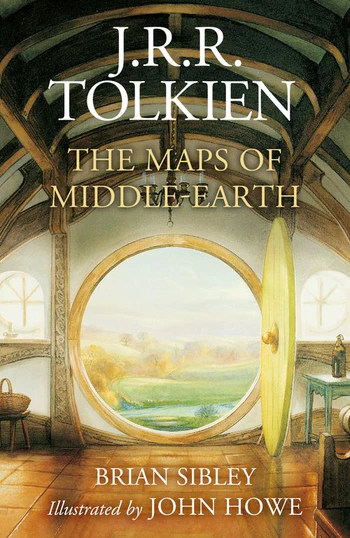
 30
30 4452
4452